#The Anti-Music Bonanza
Note
For the top 5 prompt: Top 5 Eggman boss battles.
This is yet another list that probably shifts depending on the day, because there's a lot of good ones.
5.

An underrated one. Like Rush Adventure in general.
There's no deep reason, I just think it's a neat fight, and since it uses the Jeweled Scepter, that grants it a plethora of unique magical attacks that you don't often see in an Eggman battle.
4.

I couldn't decide between these two, so fuck it, they're both here. Can you blame me? They're both well-known, and for good reason.
The Egg Walker marks the end of Tails' story, and it follows up the race to the missile in the city. The battle itself is fine, if perhaps a bit easy, but Eggman's tranquil fury in the cutscene prior really sells the mood. Shame he's rarely been given opportunities to show that side of himself since then. But that's where Stellar comes in. Either way, between that and Tails standing his ground, it's a great moment for both characters.
As for the Viper, we all love the obvious meme, but like the Walker, the fight is also fun in itself, and is reasonably tricky for a final boss. But as weird as it might be to say, the ending is what really makes it for me. The way the music stops the instant you get the last hit in, the way Tikal warns you about his kamikaze dive, the way the lonely sound and visuals of the explosion lingers before culminating with what could be mistaken for a volcanic eruption... awesome.
3.

It's an awesome mech. It's an awesome battle. It's an awesome moment for both the hero and the villain. Capped off with descending towards the center of the earth. As someone who considers Unleashed flawed in ways that I can't ignore, even I can't deny that this is one of the game's standout moments, and it deserves all its praise. I'd argue it's a better final boss than the actual final boss, and I'm not just saying that because the latter is another giant monster... okay, maybe that's part of it.
Shout out to the Generations version, because I really enjoy that one in its own right.
2.

Oh boy, here comes the controversial one. How dare I put anything from Forces on a top five that isn't derogatory, amirite.
In all seriousness... look, say what you will about the fight itself. I think it's alright, but I get why it might be considered perhaps a little anti-climactic compared to what it could have been as far as gameplay goes. And you guys know that I always consider gameplay to come first and foremost, no matter how good or bad the story of the game in question is, so it's not like I'm ignoring that part. And of course, there's the Nega-Wisp Armor reskin aspect that everyone complains about, which caused Twitter to throw the baby out with the bathwater and consider Eggman's position as the final boss to be the true problem. Which is probably why the final boss of Frontiers ended up being a talking ballsack. Thanks, everyone.
Anyway, all that said, I think there are certain elements that elevate it in spite of its ultimately okay status. There's the music, but that goes without saying for a Sonic game that isn't Chronicles. But another factor is the combination of the seriously underrated sound design, with the complete and utter silence on Eggman's part, which like @skaruresonic, I interpret it as the doctor being too focused on killing your ass that he disregards his usual banter, and like the Egg Walker cutscene in SA1, I think the effect really works, regardless of the actual intent or reason behind it.
So yes, I'm putting it as #2 for these overlooked attributes. I'm not sorry.
1.

The finale of S3&K will always be particularly special to me. There have been many great Eggman throwdowns, but this one illustrates how the doctor's high octane levels of pure determination rival Sonic's own; perfect for an arch-nemesis. There have been godlike figures who go down after a single fight, meanwhile this mortal man belts out a bonanza, because the mere concept of giving up the Master Emerald does not compute.
The build-up also goes a long way: S3&K as a whole establishes and maintains this aspect of Eggman's character throughout. He's going to get the Death Egg back up and running, and nothing is going to stop him. His robots set the jungle on fire. He himself destroys the ruins in Marble Garden, in the hopes that Sonic will get killed in the process. He's not even phased when the Death Egg falls smack dab into a volcano; his dedication never wavers. Then come the endgame, where he finally fucks off with the Master Emerald after telling Knuckles it was Nothing Personnel Kid, which is followed up with a dramatic chase through the crumbling Sky Sanctuary, which then culminates in the final showdown aboard the eponymous vessel... and then continues even after it blows up.
It's iconic, it's fun, it's climactic, and Eggman's ridiculously exaggerated refusal to quit being on full display cements it as one of my favourite Eggman portrayals, despite hailing from a 2D game with no dialogue.
Honorable mentions (that currently come to mind):
Death Egg Robot, cause c'mon, it's a classic. This mostly refers to the original Sonic 2 version as well as the variations in Generations and Mania.
Egg Shrimp (Sonic Advance 2), for being petty enough to abduct Vanilla after his plan's been foiled, and for the badass moment afterwards in which Sonic narrowly saves Vanilla.
Egg Emperor, because I don't care if it's Metal Sonic, it's an Eggman mech, he's trying to mimic Eggman, shut the fuck up or I'll do a in-depth Shadow the Hedgehog level tier list. The design is rad as hell, and it has the iconic TAKE THI-TAKE THIS, TAKE THI-TAKE THIS.
Egg Salamander (Sonic Rush), for capping off the dynamic between Sonic and Blaze... and because Wrapped in Black.
Nega-Wisp Armor, because the fight is fun despite its simplicity, and it's noteworthy because Eggman finally got to be the true final boss of a 3D mainline installment for the first time. And it only took a decade...
The endgame for Mania, in which Eggman menacingly jumps around in a Pokeball and then holds his own in a three-way standoff instead of being tactlessly upstaged like he's nothing.'
The one in IDW that doesn't exist.
13 notes
·
View notes
Text
Thursday Thrill: Thrilling events of the Week!

WhatsOn editor, Nicole Newman has come up again with fantastic events for the week. The events are going on and before it gets over get your shoes for having some fun this week. Here are some of the great events for the week.
Defected Croatia
4 - 9 Aug
For six days and seven nights in August the biggest growing family of Defected fans, house heads of all generations, and over 80- world-class DJs and musicians gathering for the continental Defected Croatian festivals of your dreams. This is the most talked about EDM festival of the season on the annual festival seasons calendar. This year Defected Croatia includes one of the biggest European destinations of a smorgasbord line ups of global first-class DJs including Defected’s boss Simon Dunmore, and a line up of Defected royalty including Eats Everything, The Shapeshifters, Gorgan City, Low Steppa, Bob Sinclar, Honey Dijon, Dave Lee ZR, Melvo Baptiste, Roger Sanchez, Dimitri from Paris plus many more fabulous people
Get ready to get Defected!
For more info & Tickets defected.com
We Are FSTVL
6 – 7 Aug
The awarding-winning dance music festival We Are FSTVL is ready for its August Essex takeover! Bringing in some of the hottest dance music labels to the mammoth stages of this two-day, weekend danceathon extravaganza. Returning to its location at Damyns Hall Aerodrome, Upminster. Upping its anti-the no 1 Essex festival and a firm favourite for the Londoners, going to this non-camping dance music event are in for a treat of their lives. The promoters leave no stone unturned to ensure this is the most golden ticket event taking place in outer London. We Are FSTVL, delivers on the mega festival experience with attention to detail on stage production with the utmost consideration on booking out No 1 DJs on demand from around the globe. With 30,000 electronic music-loving fans putting on their finest attire for one of the best-dressed festivals to be at. This year’s stellar lineup features Mabel, Camelphat, Andy C, Carl Cox, Loco Dice, Sonny Fodera Craig David, KSI, Tyga, Jamie Jones, Patrick Topping, and Rudimental, Deborah De Luca, Armand Van Helden, Shy FX, and so many more fabulous DJs.
Essex is time to get your shuffle on!
For more info & Tickets wearefstvl.com
Wilderness Festival
4 – 7 Aug
August is upon us already and midway through the festival calendar. This year’s festival season has only got better and better as we headed on, through the summer of 22. The road trip destination for this weekend is taking festivalgoers to Cornbury Park in the heart of Oxfordshire. The Wilderness four-day festival bonanza is one of the most beautiful UK boutique festivals of the year. It’s a weekend for letting loose and getting your best rave on.
The multi-facet awarding winning festival encompasses the bigger picture of a full-on festival experience combining live music, arts, plenty of getting one with nature which will embrace your well-being, like taking a dip in the lakeside spa furthermore there is an array of theatre productions, artisanship, and top of the agenda are the late-night parties featuring a host of the dance music finest DJs and musicians to boot. This is one of those standout festivals that are sure to soothe your soul. The artist lineup includes Underworld, Eats Everything, David Morales, Derrick Carter, Yousef, Jungle, Years & Years, Peggy Gou, Róisín Murphy, Craig Charles, and so many more.
Don’t forget your bathers!
For more info & Tickets wildernessfestival.com
Read the full article
0 notes
Text
Omstreifere oppsummerer det norske musikkåret
Omstreifere har satt sammen en liste over våre norske favoritt-utgivelser fra året 2017. På samme tid i fjor betegnet vi året 2016 som et usedvanlig godt musikk år for oss som liker americana, country og beslektede sjangre. Jaggu, har året 2017 har vært minst like fantastisk som fjoråret!
Hver uke skriver Omstreifere på våre Facebook-sider om en låt som har utmerket seg i uka som har gått i spalten «Ukas låt». Ofte inneholder denne spalten også en hyllest til albumet låten er hentet fra. Sitatene om albumene nedenfor er hentet fra denne spalta.
Trykk her for spilleliste.

1. «Alt som har hendt» - Erlend Ropstad
Første singel fra albumet «Alt som har hendt» ble sluppet i august. Jeg husker veldig godt mitt første møte med denne låta. Det var en kjip dag. Det meste var svart selv om det var lyst ute. Da denne låta dukka opp i høretelefonene mine sang Ropstad akkurat det jeg trengte å høre. Jeg har ikke for vane å sette enkeltlåter på repeat, men denne kvelden snurret denne ene låta inne i hodet mitt i over en time. Etterpå var alt litt bedre.
Siden august har denne låta blitt spilt jevnlig. Ofte mange ganger hver dag.
For et par uker siden kom endelig albumet. Ropstad slo meg i bakken igjen. Det var en heftig opplevelse. Jeg klarer ikke å beskrive det på noen annen måte. Jeg har prøvd å tenke tilbake. Prøvd å tidfeste sist jeg ble så berørt av et album. Jeg tror jeg må tilbake til 1999. Til året Thåstrøm ga ut albumet «Det är ni som e dom konstiga det är jag som e normal».
Og, da tror jeg egentlig jeg har fått sagt det som skal sies om denne plata.
- Henning

2. «No Offending Borders» - Torgeir Waldemar
Et album som stadig har blitt plassert høyere og høyere opp på min liste over årets beste album. Torgeir Waldemars «No Offending Borders» fikk noen runder da det ble sluppet i begynnelsen av året, men strømmen av fantastiske plater fikk meg raskt til å legge dette albumet til side. Jeg husker jeg likte flere av låtene, men jeg tok meg aldri tid til å fordype meg skikkelig i denne utgivelsen. I slutten av november og utover i desember har jeg endelig oppdaget hvor bra dette albumet er. Det blir spennende å se hvilken plassering denne plata får på listene våre når vår selvpålagte deadline går ut like etter julaften. Jeg kan allerede nå røpe at «No Offending Borders» er inne på en sikker topp 5-plassering.
- Henning

3. «Triste Sanger og Vals» - Roger Græsberg & Foreningen
Omstreiferes kjærlighet til Finnskogen strekker seg lenger enn til møte med tettvokst furuskog og uberørt natur. Fra tid til annen kommer det også musikk ut fra «de dype skogene», en skog Omstreifere aldri kommer helt til bunns i. Roger Græsberg & Foreningen, med Roger Græsberg fra Finnskogen i spissen, har akkurat debutert med plata «Triste Sanger og Vals» til strålende anmeldelser fra både lokal-og landsdekkende presse. Gratulerer!
«Triste Sanger og Vals» vil snurre og gå kommende helg i kjærra til Omstreifere. Da setter vi kursen mot Finnskogen for å dokumentere livene til noen av menneskene som bor de. Kanskje klarer vi å bli litt klokere på hva Finnskogen er med Roger Græsberg & Foreningen som helgens soundtrack?
Henning Benjaminsen i Omstreifere ha tatt coverbildet på plata og pressebildene av bandet. Vi kommer derfor ikke til å anmelde denne plata.
- Martin
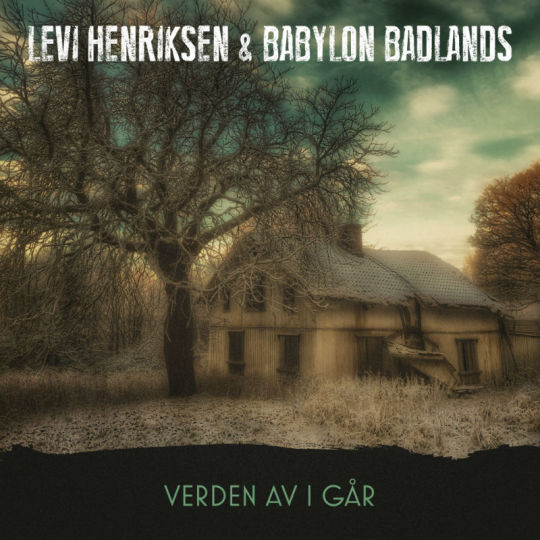
4. «Verden av i går» - Levi Henriksen & Babylon Badlands
Vi laget aldri noen anmeldelse av dette albumet, men Omstreifere var tilstede på slippfesten for albumet. Rapport fra denne festen kan leses her.

5. «Old Soul» - Unnveig Aas
Unnveig Aas har lenge vært stjerne i undergrunnen. I 2013 ga hun ut sin første EP «Time Has Changed Us», i 2014 slapp hun singelen «How Long Must A Woman Mourn» og i 2015 ga hun oss fine «Love EP». I dag kom endelig debutalbumet hennes «Old Soul» ut. Debutalbumet kommer til å gjøre henne kjent blant allmenheten, bli spilt i radio, Aas vil bli invitert til Lindmo og spille på de største festivalene. Jaggu kommer hun til å slå igjennom internasjonalt også. Oslo vil bli betegnet som den nye americana-hovedstaden i Europa. Hvis det finnes rettferdighet.
- Henning

6. «The Secret Sound of Dreamwalkers» - The Secret Sound of Dreamwalkers
Aasvang og bandet hennes tar oss med på en vanvittig reise i et virvar av forskjellige stemninger og sjangere. Vi er innom hjerteskjærende country, breibeint 70-tallsrock, syretripper og ørkenlandskap. Tenk deg en vellykket kollasj av vuggesang, Cowboy Junkies, Emmylou og Parsons, 80-talls soul, Black Sabbath og masse andre greier jeg ikke helt klarer å beskrive.
- Henning

7. «Palomino Motel» - Trond Svendsen & Tuxedo
I slutten av april fikk jeg stukket til meg en cd fra Rootsy-Vikeke som hun insisterte på at jeg måtte høre på. Dagen etter, grytidlig mandag morgen, putta jeg plata i cd-spilleren i bilen. Hodet verka etter en pils for mye på konserten jeg var på dagen før. Snøen lavet ned. Bilen skrangla, den skulle egentlig vært på eu-kontroll for et par måneder siden. Har utsatt det i det lengste, vet at det kommer til å bli dyrere enn jeg har råd til. Har stått opp altfor seint og vet at jeg snart kommer til å sitte fast i køen inn til byen.
Plata som blir spilt på anlegget snurrer en stund før jeg registrerer musikken. Vokalistens stemme blander seg med en kvinnestemme og instrumentene klager. Jeg skrur opp volumet og musikken som fyller bilen passer perfekt for snøstorm i april. Noen ganger treffer musikk knallhardt og uventet. Dette var en slik opplevelse. Plata rekker å snurre to og en halv gang før jeg kom dit jeg skulle. Denne dagen kunne godt køen gjennom byen vart evig.
- Henning

8. «Southern Insecurity» - Country Heroes
Jeg drømmer stadig om Amerika. Jeg drømmer om å oppsøke brune buler der countrymusikken strømmer mot meg fra ei lita scene. Døse melankolsk i et hjørne med ei kald ølflaske foran meg på bordet. Sovne på et billig motell og dagen etter kjøre videre til neste by. Stoppe på en diner og ta en milkshake og en burger. På veiene suser den ene fete amerikaneren etter den andre forbi meg i motsatt retning. Jeg retter på hatten, tenner en sigarett, trøkker gassen i bånn og sikter på noen heftige fjellformasjoner i horisonten. Jeg drømmer mest sannsynlig om et Amerika som ikke finnes.
Drit i virkeligheten. Den norske gruppa Country Heroes tar meg med til en perfekt verden, der jeg kan oppleve slike ting som jeg fablet om ovenfor. Til en verden der dressene fortsatt er av polyester, der røyking ikke er farlig og skikkelig country strømmer ut av høyttalere og fra små scener til enhver tid.
Plata «Southern Insecurity», som nettopp kom ut på labelen Safe and Sound recordings, har magien som skal til for å kunne forandre en grå hverdag til ei sein natt på min drømme honky-tonk bule.
For en stemme og for et stødig band! For ei herlig country plate denne gjengen leverer!
- Henning

9. «In Central European Time» - Dig Deeper
Omstreifere omtalte aldri dette albumet på våre Facebook-sider og har derfor ingen tekst å sakse sitater fra.

10. «El Dorado» - The Anti-Music Bonanza
The Anti-Music Bonanza serverer oss et album proppfullt av klassisk boogie-rock iblandet kledelige doser skranglete country. Allerede i åpningslåta drypper det svette av cowboyhatten til vokalist og låtskriver Græsberg. Herfra og ut er det full fest i lokalet. Bandet gliser seg gjennom platas ti låter og serverer oss en uimotståelig suppe bestående av alle de riktige klisjeene fra musikkhistorien i blandet en stor dose kjærlighet til sjangerne de stjeler ubeskjedent fra. Plata er spilt inn i legendariske Silence Studio og det er tydelig at bandet hadde en strålende helg langt inne i de svenske skoger da denne plata ble festet på tape.
- Henning

11. «The Santa Ana» - Sugarfoot
Der det forrige albumet hadde en mer rendyrket stemning, spriker dette albumet i flere retninger. De mer poppa og lystige låtene får mer plass enn de gjorde på «Different Stars», men vi blir også servert herlig kosmisk countryrock, og deilig gitarøs med klare hint til Neil Young.
«The Santa Ana» ser ut til å bli mitt sommeralbum denne sesongen og når høsten kommer tror jeg jaggu plata fortsatt kommer til å funke helt utmerket.
- Henning

12. «Klokkene ringer!» - Onkel Tuka
Jeg sluker store mengder musikk. Hver eneste dag. Det har jeg gjort denne uka også, men denne uka har ingenting festa seg ordentlig. Jeg vet det har kommet ut plater som jeg garantert kommer til å høre masse på de nærmeste ukene og som kanskje vil komme høyt opp på listene mine når dette året skal oppsummeres. Colter Wall har endelig sluppet sitt etterlengtede debutalbum, norske Sugarfoot er aktuelle med ny skive og en av mine favorittartister, Daniel Romano, har med sin ferske plate fått bloggkollegaer og anmeldere til å overgå hverandre av begeistring. Dette er plater jeg vet jeg kommer til å få glede av, men ingenting har altså festa seg skikkelig. Bortsett fra en låt; Onkel Tukas «Tater» fra deres siste plate «Klokkene Ringer!».
Onkel Tukas nye skive kommer sannsynligvis også til å begeistre meg i ukene som kommer.
- Henning
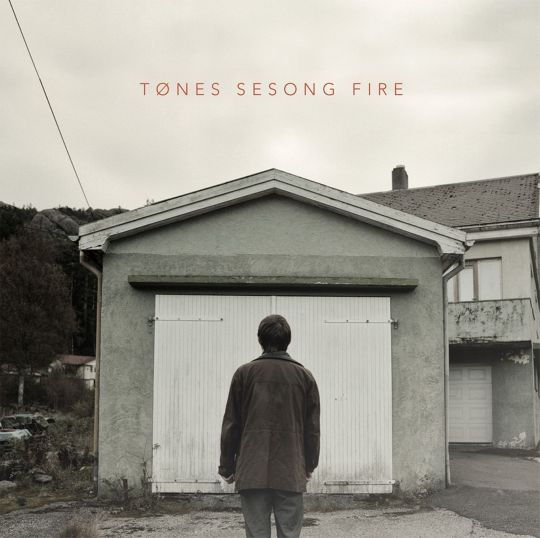
13. «Sesong Fire» - Tønes
Tønnesen har gjort det igjen. Han har laga strålende musikk basert på historiene til oss helt vanlige folk. Bernt, Peder og alle hverdagsheltene som bidrar til at samfunnet henger i hop. De som gjør det beste ut av det de har i vonde og gode dager, for å bruke en av Tønnesens tekstlinjer.
- Henning
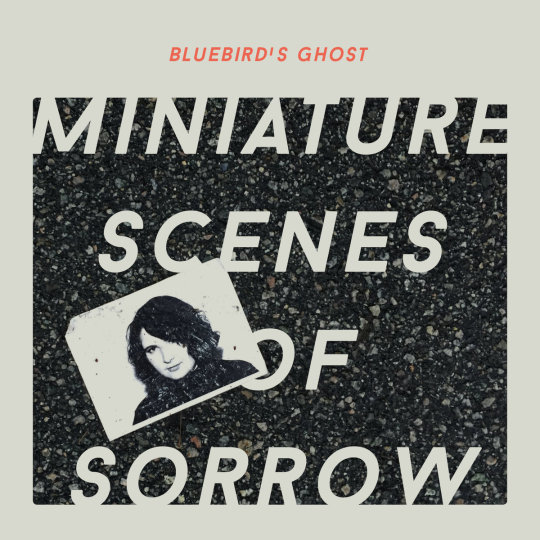
14. «Miniature Scenes of Sorrow» - Bluebird’s Ghost
Omstreifere satte stor pris på Ep’en «This Too Shall Pass» som duoen slapp i fjor og låta «Ragged Earth» fra denne Ep’en fikk en velfortjent plass på vår liste over fjorårets beste norske låter. Med denne utgivelsen fortsetter duoen å imponere. Sju lavmælte låter inspirert av amerikansk mountain music og blugrass spilt og sunget på en aldeles fabelaktig og gåsehudfremkallende måte.
Lydbildet er sparsomt og nedtonet og gir akkurat nok plass til ekteparets rørende harmonier. Lyden som strømmer ut av høretelefonene har ved flere anledninger gitt meg akutt behov for å legge meg ned på gulvet, stenge alle andre inntrykk ute og bare nyte musikken.
- Henning

15. «Blåe Drag» - Tove Bøygard
Omstreifere omtalte aldri dette albumet på våre Facebook-sider og har derfor ingen tekst å sakse sitater fra.
#Erlend Ropstad#Torgeir Waldemar#Roger Græsberg & Foreningen#Levi Henriksen & Babylon Badlands#The Secret Sound of Dreamwalkers#Trond Svendsen & Tuxedo#Country Heroes#Dig Deeper#The Anti-Music Bonanza#sugarfoot#Onkel Tuka#tønes#Bluebird's Ghost#Tove Bøygard#Omstreifere#Årets beste norske album 2017#Favoritt album 2017#Best of 2017
2 notes
·
View notes
Text
Ultraviolet
By Hale13
For the Summer of Whump Day 7 - Sunburn
The best part about having free run of Tony Stark’s penthouse in the Tower is the Olympic sized pool that overlooks all of Manhattan. Peter could happily spend the whole summer here.
Words: 2503, Chapters: 1/1 (Complete), Language: English
Fandoms: Spider-Man (Tom Holland Movies)
Rating: Gen
Relationships: Peter Parker & Tony Stark
Characters: Peter Parker, Tony Stark, Bruce Banner
TW: Teenage Dumbassery
Read on AO3 or below the line break.
“Why are you wearing the Armani?” Peter asked, pushing the pair of battered bodega sunglasses he had been using for the past two years up to sit in his chlorine damp hair and squinting as his eyes adjusted to the dimmed lights of the penthouse. FRIDAY closed the automatic door to the balcony and pool behind him.
“First of all this is Tom Ford how dare you,” Tony said, pointing at him with the ‘dad finger’ but not looking up from his rapid texting. “Second of all I’m wearing the Tom Ford, not Armani you absolute heathen, because I have to step into a couple of meetings this afternoon.”
Peter hummed in confusion, taking a bottle of cold Gatorade (the red one because it was clearly the best flavor) from the fridge and chugging it before sitting on one of the barstools. Tony flicked his eyes away from his phone to glare at the puddle dripping off Peter’s swim trunks pointedly – Peter just smirked at him and cracked open the second bottle he had pulled from the fridge, sipping on it slowly. “I thought you were playing hooky all week?” Peter teased, referencing the plan Tony had laid out earlier in the week to do absolutely nothing of value while Pepper was out of town.
“That was the plan,” Tony conceded, tucking his phone into his inner jacket pocket and then fussing with the immaculate pocket square. “Pepper was supposed to land thirty minutes ago but she had to divert her plane to our LA office for… something. Honestly I wasn’t paying attention.”
“And that leads to you going to meetings?” Peter asked with a raised brow.
“Apparently,” Tony groused, pulling the colorful beach towel from around Peter’s neck and dropping it to the floor to soak up the puddle forming under the barstool. “Sorry buddy – I know I promised a week of fun bullshit but I think we both would prefer that I keep my head attached to my body so…”
“It’s fine,” Peter brushed off and it really was. To be honest, he was still tired from their thirty hour workshop bonanza and he could do with a nap. It was a pleasant day for June in New York with a good breeze and some light cloud cover – a nap on one of the obscenely large pool floats sounded heavenly. “I was thinking about napping anyway.”
Tony’s brow furrowed for a second before his hand darted out to land on Peter’s forehead. Peter batted his hand away, narrowly avoiding falling off the stool. “You don’t feel warm. Are you sick? FRI is the kid sick?”
“All vitals within normal limits Boss,” FRIDAY answered, almost sounding amused.
“I’m not sick! Teenagers can enjoy naps you know.” Peter protested, dodging another of his mentor’s attempts to check him for a fever. “It’s pretty much our MO actually.”
Tony rolled his eyes before slipping his tinted AR sunglasses onto his face. “Oh to be young again,” he said sarcastically, gathering up a couple thin files and his StarkPad, tucking his phone into his inner jacket pocket. “You sure you’ll be okay for a few hours?”
“Yes, Tony, jeez.” Peter said with an exaggerated eye roll.
“Oh joy, teenage snark. Aren’t I lucky?” His mentor questioned as he ruffled Peter’s hair into disarray, flinging little water droplets on the counter top and causing the loose curls to tighten up more as they dried. “I’ll be back in time for dinner. Want to grill?”
“Sounds good,” Peter said with a smile, finishing off his second drink and tossing the bottle in the recycling and waving as Tony entered the elevator. Peter let out a large yawn and stretched, sighing happily as his back popped and realigned, before hopping of the stool to gather his towel off the floor and get a couple bottles of water from the fridge.
The sun was bright and warm as he stepped back out onto the pool deck and Peter luxuriated in its warmth, momentarily blinded – he hated the cold more than anything and loved being out in the heat. It took him a few minutes to pick his pool float, Tony had collected an obscene number of ridiculous ones over the past month, but he eventually decided on the watermelon one for its large round shape. He loaded it up with his water, towel and sunscreen before pushing it into the pool and following it with a splash.
He agilely climbed up to sit in the middle and took the bottle of sunscreen, spraying on another protective layer before wadding his towel into a lumpy pillow and face planting into it. “Hey FRI?”
“Yes Peter?” FRIDAY’s voice asked from the waterproof speakers situated around the pool.
“Can you play my lofi playlist?” He nearly slurred, already half asleep.
“No problem Peter,” she answered before the soft music poured from the speakers and Peter let out a sigh before fully relaxing. There was truly nothing better than a nice warm nap out in the sun. The gentle rocking of the water was quick to put him into some of the best sleep of his life.
————————————————
“Peter? Peter! Wake up kiddo!”
Peter groaned, his body stiff and tight and hot and he cracked open his crusty eyes to stare at the edge of the pool. “T’ny?” He croaked out, mouth impossibly dry and vision blurred.
“Yes, Jesus, you really cooked yourself buddy. Can you paddle over here?” Tony was looking at him with worried eyes, pulling his jacket off and slipping out of his Italian leather loafers.
“Come over there?” Peter questioned, confused. The sun had sunk behind the tower and the rooftop was now covered in shade and Peter shivered. Why was it so cold?
“Pete focus up now. I need you to come to me.” Tony said, his voice patient but with the clear undercurrent of concern that he used when Peter had gotten himself into some form of trouble.
“Okay,” Peter grunted. He tried to shift his heavy arms and then gasped in pain, clenching his eyes shut. “Ouchies,” he mumbled, not making any effort to move again. A splash sounded and Peter opened his eyes to see Tony in the water with him, efficiently swimming over to his ridiculous pool float. “But Tom Ford,” Peter protested dumbly.
“This was last seasons suit anyway,” Tony dismissed as he reached the edge of the float, treading water. “I’m gonna help you get into the water Petey – you’re way too hot. It’s not going to feel all that great but you need to trust me alright?”
“You’re Iron Man,” Peter agreed, groggy. “Trust you.”
“Good to know buddy,” Tony said as he carefully reached out and put his arms under Peter’s chest. Peter let out a gasp as his mentor’s wet sleeve rubbed against his sensitive arm but kept his body limp and let Tony maneuver him to the edge of the float while barely keeping it from tipping completely over on them both. “Alright kiddo, take a deep breath for me and hold it okay?”
“Yeah,” Peter grunted before pulling in a large gulp of air and squeezing his eyes shut. To his benefit, Tony was fast – he lifted Peter off the float and dumped him into the water before hooking his forearms under Peter’s armpits and pulling his head up above water again. Peter coughed as he surfaced, more awake and aware now, and really feeling just how truly fucked he was. His skin from the back of his neck down was tight and burning and he remained limp to not stress out the damaged skin any more. “That sucked.”
“Sure did,” Tony agreed, carefully paddling the both of them to the shallow end of the pool where a gentle incline would lead back up to the pool deck. “Think you can walk if I help you?”
“Maybe,” Peter answered, but did adjust himself in the water so he was floating next to Tony with his arm wrapped around the man’s shoulder and Tony’s arm wrapped around his waist just below the edge of his swim trunks to prevent him from touching the tender skin of his back. Exiting the pool was difficult since Peter realized he had definitely burned the bottoms of his feet but, with Tony’s help, he was able to limp out of the pool and towards the penthouse door.
“We’ve gotta get you in some oatmeal,” Tony told him as they entered the living room. The cool air from the AC made Peter shiver but the cool polished concrete floor felt like heaven on the soles of his feet.
“Why oatmeal?” Peter asked, letting Tony steer him down the hall and past his own bedroom towards the master bedroom and into Tony’s own ridiculously huge bathroom.
“It’s an anti-inflammatory,” Tony told him as they entered the bathroom. The large porcelain tub that could probably fit seven or eight full grown men was filling with tepid water mixed with oatmeal – clearly FRIDAY had been listening to their conversation and had acted accordingly. Well that or Peter had missed when Tony had asked her to set it up.
It took some maneuvering, but, soon, Peter was lying face down in the tub, his head pillowed on a pile of soft towels with Tony applying damp washcloths soaked in the cool water and oatmeal to the parts of his back that weren’t submerged in the water. Peter shivered violently once, his failing thermoregulating attempting and not succeeding in functioning, before he just lay, missable, in the tub.
“Close your eyes,” Tony said, wetting another washcloth in the sink with clean water only and wiping his face down. He frowned as his hand ran over Peter’s forehead and he draped the cloth over Peter’s face and eyes to cool the reddened skin. “You’ve got quite the fever brewing Webs.”
“I just wanted a nap,” Peter moaned and he heard Tony let out a little sad sounding chuckle.
“I know. Just relax and try to cool down for now,” and then he stood up and walked to the door. “I’m going to grab you some dry shorts and get the bed set up. Try not to drown.” It took more effort than Peter thought it would but flipping Tony off over the lip of the tub was totally worth it.
He fell into a light doze from there – drifting off as the stinging in his back dulled down to a more comfortable level. “Oh Peter,” Bruce said from above him and Peter jerked in the tub, dislodging the washcloth from his face and causing his body to let out a sting of pain and protest. He let out a little grunt and Dr. Banner winced from above him. “Sorry Pete. I thought you heard me come in. You really burnt yourself.”
“I know,” Peter said, wanting to be irritated but too tired to feel much of anything. Bruce gave him a sad smile.
“According to FRIDAY your temp is down enough we can get you out,” Bruce told him as Tony leaned over the tub as well so both of them were staring down at him. Peter just blinked. “Let Tony and I do most of the work – you don’t want to stress your muscles. Once we can get you out and dried off I’ll get you started on some fluids and electrolytes and that should help some. And my aloe plant donated a couple of leaves to the cause.” Dr. Banner joked. Peter gave him a weak smile in response, not really looking forward the the execution part of Bruce’s plan.
Getting lifted out of the tub was nothing short of agony even though Tony and Bruce lifted him under his armpits again and left him leaning his chest heavily against the bathroom counter to keep as much weight off his feet as possible. Bruce pointedly left the room and Peter endured a few mortifying moments where his mentor had to help him dry off and change into a loose pair of athletic shorts that sat low on his hips so as to not interfere with the burn. He was going to have an awful tan line by the end of this he thought sadly, taking in the lobster colored skin of his back and neck.
Bruce crept back in moments after and had Peter lean his hip against the sink so that he could place the IV catheter into his forearm while standing – making it easier on both of them once they would get him settled into bed. The California king sized bed had been stripped down to just its fitted sheet and, with a little assistance, Peter did a controlled flop face first into the memory foam pillows, letting his eyes shut as he felt Bruce connect the IV line and the cool rush of fluids through his veins.
He was nearly out when a cold plop on his back tore his eyes back open in surprise and he felt immediate relief from his tight, hot skin where the wet mass had landed. “Feels good,” he slurred drowsily as a careful hand massaged the goop into his back. A second set was working on his tight calf muscles, loosening them up and easing the burn.
“Fresh aloe,” Dr. Banner told him. Nothing better for a sunburn.”
Peter hummed in agreement and let himself drift off, finally comfortable.
—————————————-
“I just wanted a nap,” Peter whined as he limped and hobbled into the kitchen of the penthouse almost three days later, Tony following a few steps behind to catch him if he fell over and relying on the walls and his ability to stick to anything to keep him from falling. “I wore sunscreen!”
“Clearly not enough,” his mentor told him, voice tight with irritation. Peter had been saying the same thing on repeat since he woke up from his nap and it was clearly grating the man’s nerves. Peter opened the fridge and pulled out a bottle of water, cracking it open and taking large gulps. Even days later and after Bruce pumped him full of fluids Peter still felt parched and dehydrated. “You know you’re supposed to reapply like every hour in direct sunlight and water right?”
“Well I do now,” Peter answered, leaning against the stove so he could take the weight off his legs. His skin still felt so tight that it felt like it may burst. And the blisters… best not to think about it. Tony clocked the movement.
“Time for more aloe,” he said pointedly, shooing Peter off toward his bedroom. “I’ll get it out of the freezer and be right behind you.”
“Thanks Mr. Stark,” Peter said as he hobbled away. He passed by the door to the pool, the water sparkling brightly in the mid-afternoon sun and he looked at it thoughtfully. “Redo next week,” he promised to himself. He’d just have to get FRIDAY to wake him up every hour next time. Besides, he needed to even out his tan.
19 notes
·
View notes
Text
In serving big company interests, copyright is in crisis

Copyright rules are made with the needs of the entertainment industry in mind, designed to provide the legal framework for creators, investors, distributors, production houses, and other parts of the industry to navigate their disputes and assert their interests.
A good copyright policy would be one that encouraged diverse forms of expression from diverse creators who were fairly compensated for their role in a profitable industry. But copyright has signally failed to accomplish this end, largely because of the role it plays in the monopolization of the entertainment industry (and, in the digital era, every industry where copyrighted software plays a role). Copyright's primary approach is to give creators monopolies over their works, in the hopes that they can use these as leverage in overmatched battles with corporate interests. But monopolies have a tendency to accumulate, piling up in the vaults of big companies, who use these government-backed exclusive rights to dominate the industry so that anyone hoping to enter it must first surrender their little monopolies to the hoards of the big gatekeepers.
Creators get a raw deal in a concentrated marketplace, selling their work into a buyer's market. Giving them more monopolies – longer copyright terms, copyright over the "feel" of music, copyright over samples – just gives the industry more monopolies to confiscate in one-sided negotiations and add to their arsenals. Expecting more copyright to help artists beat a concentrated industry is like expecting more lunch money to help your kid defeat the bullies who beat him up on the playground every day. No matter how much lunch money you give that kid, all you'll ever do is make the bullies richer.
One of the biggest problems with copyright in the digital era is that we expect people who aren't in the entertainment industry to understand and abide by its rules: it's no more realistic to expect a casual reader to understand and abide by a long, technical copyright license in order to enjoy a novel than it is to expect a parent to understand securities law before they pay their kid's allowance. Copyright law can either be technical and nuanced enough to serve as a rulebook for a vast, complex industry...or it can be simple and intuitive enough for that industry's customers to grasp and follow without years of specialized training. Decades of trying to make copyright into a system for both industrial actors and their audiences has demonstrated that the result is always a system that serves the former while bewildering and confounding the latter.
But even considered as a rulebook for the entertainment industry, copyright is in crisis. A system that is often promoted as protecting the interests of artists has increasingly sidelined creators' interests even as big media companies merge with one another, and with other kinds of companies (like ISPs) to form vertical monopolies that lock up the production, distribution and commercialization of creative work, leaving creators selling their work into a buyer's market locked up by a handful of companies.
2019 was not a good year for competition in the entertainment sector. Mergers like the $71.3B Disney-Fox deal reduced the number of big movie studios from five (already a farcical number) to four (impossibly, even worse). The Hollywood screenwriters have been locked in a record-breaking strike with the talent agencies—there are only three major agencies, all dominated by private equity investors, and the lack of competition means that they increasingly are negotiating deals on behalf of writers in which they agree to accept less money for writers in exchange for large fees for themselves.
On top of that, the big entertainment companies are increasingly diversifying and becoming distribution channels. The Trump administration approved the AT&T/Time-Warner merger just as the Obama administration approved the Universal/Comcast merger a decade earlier. Meanwhile, Disney has launched a streaming service and is pulling the catalogs of all its subsidiaries from rival services. That means that the creators behind those works will no longer receive residual payments from Disney for the licensing fees it receives from the likes of Netflix—instead, their work will stream exclusively on Disney Plus, and Disney will no longer have to pay the creators any more money for the use of their work.
To top it all off, the DOJ is working to end the antitrust rule that bans movie studios from owning movie theater chains, 70 years after it was put in place to end a suite of nakedly anti-competitive tactics that had especially grave consequences for actors and other creative people in the film industry. Right on cue, the already massively concentrated movie theater industry got even more concentrated.
The most visible impact of the steady concentration of the entertainment industry is on big stars: think of Taylor Swift's battle to perform her own music at an awards show where she was being named "Artist of the Decade" shortly after rights to her back catalog were sold to a "tycoon" whom she has a longstanding feud with.
But perhaps the most important impact is on independent creators, those who either cannot or will not join forces with the entertainment giants. These artists, more than any other, depend on a free, fair and open Internet to connect with audiences, promoted and distribute their works and receive payments. The tech sector has undergone market concentration that makes it every bit as troubled as the entertainment industry: as the New Zealand technologist Tom Eastman wrote in 2018, "I'm old enough to remember when the Internet wasn't a group of five websites, each consisting of screenshots of text from the other four."
The monopolization of the online world means that all artists are vulnerable to changes in Big Tech policy, which can see their livings confiscated, their artistic works disappeared, and their online presences erased due to error, caprice, or as collateral damage in other fights. Here, too, independent artists are especially vulnerable: when YouTube's Content ID copyright filter incorrectly blocks a video from a major studio or label, executives at the company can get prompt action from Google -- but when an independent artist is incorrectly labeled a pirate, their only hope of getting their work sprung from content jail is to make a huge public stink and hope it's enough to shame a tech giant into action.
As online platforms become ever-more-central to our employment, family, culture, education, romance and personal lives, the tech giants are increasingly wielding the censor's pen to strike out our words and images and sounds and videos in the name of public safety, copyright enforcement, and a host of other rubrics. Even considering that it's impossible to do a good job of this at massive scale, the tech companies do a particularly bad job.
This is about to get much worse. In March 2019, the European Union passed the most controversial copyright rules in its history by a razor-thin margin of only five votes—and later, ten Members of the European Parliament stated that they were confused and had pressed the wrong button, though the damage had already been done.
One of the most controversial parts of the new European Copyright Directive was Article 17 (formerly Article 13), which will require all online platforms to implement copyright filters similar to Google's Content ID. The Directive does not contain punishments for those who falsely claim copyright over works that don't belong to them (this is a major problem today, with fraudsters using fake copyright claims to threaten the livelihoods of creators in order to extort money from working artists).
Article 17 represents a bonanza for crooks who victimize creators by claiming copyright over their works—without offering any protections for the artists targeted by scammers. Artists who are under the protective wing of big entertainment companies can probably shield themselves from harm, meaning that the heavily concentrated entertainment sector will have even more leverage to use in its dealings with creators.
But that's not all: Article 17 may have snuffed out any possibility of launching a competing platform to discipline the Big Tech firms, at least in Europe. Startups might be able to offer a better product and lure customers to it (especially with the help of Adversarial Interoperability) but they won't be able to afford the massive capital expenditures needed to develop and operate the filters required by Article 17 until they've grown to giant size—something they won't get a chance to do because, without filters, they won't be able to operate at all.
That means that the Big Tech giants will likely get bigger, and, where possible, they will use their control over access to markets and customers to force both independent creators and big media companies to sell on terms that benefit them, at the expense of creators and entertainment companies.
To see what this looks like, just consider Amazon, especially its Audible division, which controls virtually the entire audiobook market. Once a minor sideline for publishing, audiobooks are now a major component of any author's living, generating nearly as much revenue as hardcovers and growing much faster.
Amazon has abused its near-total dominance over the audiobook market to force creators and publishers to consent to its terms, which include an absolute requirement that all audiobooks sold on Audible be wrapped in Amazon's proprietary "Digital Rights Management" code. This code nominally protects Audible products from unauthorized duplication, but this is a mere pretense.
It's pretty straightforward to remove this DRM, but providing tools to do so is a potential felony under Section 1201 of the Digital Millennium Copyright Act, carrying a penalty of a five-year prison sentence and a $500,000 fine for a first offense (EFF is suing the US government to overturn this law). This means that potential Audible rivals can't offer tools to import Audible purchases to run on their systems or to permit access to all your audiobooks from a single menu.
As Amazon grows in scale and ambition, it can, at its discretion, terminate authors' or publishers' access to the audience it controls (something the company has done before). Audiences that object to this will be left with a difficult choice: abandon the purchases they've made to follow the artists they love to smaller, peripheral platforms, or fragment their expensive audiobook libraries across a confusion of apps and screens.
Copyright was historically called "the author's monopoly," but increasingly those small-scale monopolies are being expropriated by giant corporations—some tech, some entertainment, some a weird chimera of both—and wielded to corner entire markets or sectors. In 2017, EFF lost a long, bitter fight to ensure that a poorly considered project to add DRM to the standards for Web browsers didn't result in further monopolization of the browser market. Two years later, our worst fears have been realized and it is effectively impossible to launch a competitive browser without permission from Google or Microsoft or Apple (Apple won't answer licensing queries, Microsoft wants $10,000 just to consider a licensing application, and Google has turned down all requests to license for new free/open-source browsers).
Copyright has also become a key weapon in the anticompetitive arsenal wielded against the independent repair sector. More than 20 state-level Right to Repair bills have been killed by industry coalitions who cite a self-serving, incoherent mix of concerns over their copyrights and "cybersecurity" as reasons why you shouldn't be able to get your phone or car fixed in the shop of your choice.
All this is why EFF expanded its competition-related projects in 2019 and will do even more in 2020. We, too, are old enough to remember when the Internet wasn't a group of five websites, each consisting of screenshots of text from the other four. We know that, in 2020, it's foolish to expect tech companies to have their users' back unless there's a meaningful chance those users will go somewhere else (and not just to another division of the same tech company).
(Crossposted from EFF Deeplinks)
https://boingboing.net/2020/01/22/in-serving-big-company-interes.html
68 notes
·
View notes
Text
Various Artists — Dreams to Fill the Vacuum: The Sounds of Sheffield 1978-1988 (Cherry Red Records)

youtube
By the late 1970s Sheffield was on the edge. The erstwhile industrial powerhouse was crumbling under the weight of recession, the decline of manufacturing, rising unemployment and the degradations of Conservative Party policies and especially Margaret Thatcher’s war on labor and the welfare state. A common theme in the contemporary history of other great northern economic centers like Manchester, Liverpool and Leeds that formed the backdrop to the fecund art and music scenes that germinated among the ruins.
Dreams to Fill the Vacuum: The Sounds of Sheffield 1978-1988 showcases a decade of experimentation over four CDs and 83 tracks. The cadences of the once busy factories, the frustrations of the unemployed, the fury of those left on the shelf, the DIY ethos fueled by punk, restless experimentation; it’s all here from ragged noise to slick white funk, from electronic noodling to industrial noir, post –punk to indie jangle. Future MTV staples The Human League, ABC and Thompson Twins, underground legends Clock DVA and The British Electric Foundation, early showings from present day Sheffield treasures Jarvis Cocker and Richard Hawley and a raft of coulda-beens, shoulda-beens and never-weres lovingly brought to light by the ever digging folk at Cherry Red who have already excavated gold from Scotland (Big Gold Dreams), Manchester (Manchester North Of England) and Liverpool (Revolutionary Spirit).
Although Cabaret Voltaire do not appear their influence is felt as inspirations, producers and owners of the famous Western Works studio which was housed in a derelict cutlery factory and has since been demolished.
Disc One 1977-1981 opens with an early instrumental from The Human League. “Dancevision” unites the band’s familiar synths and drum machines with a rumbling punkish bass line that sounds like a cross between Warsaw and OMD. They Must Be Russians contribute a lesson on STD’s taken from a student nurses’ pamphlet interspersed with an insistent guitar thrash on the hilarious but danceable “Don’t Try to Cure Yourself”. I’m So Hollow’s single that provides the box set’s title is classic early post-punk that sounds timeless with its snare heavy beat, thick layers of guitar, straight ahead bass and earnest vocals. B Troop’s “Junior” adds saxophone, keyboards and funk-influenced bass to the mix from whence the sound of post New Romantic white English soul peeps out. The Toy Shop provides “The Maze” a nicely warped piece of synth pop augmented by choppy guitar and a carnivalesque keyboard riff.
Disc Two: 1981-1982 starts with the extended version of Heaven 17’s still relevant “(We Don’t Need This) Fascist Groove Thang” a mix tape staple that sound-tracked every student party in the day. Further highlights like Surface Mutants’ excellent dub experiment “Train”, Clock DVA’s industrial noir single “4 Hours” with its wailing clarinet, superb bass line and Adi Newton’s tale of urban alienation, Flying Alphonso Brothers’ “War Games” an Aztec Camera like piece of melodic indie pop, the new wave thump of Shy Tots “English Industrial Estate”, the proto-goth of Stunt Kites’ “Deity’s Lament” are worth the admission price.
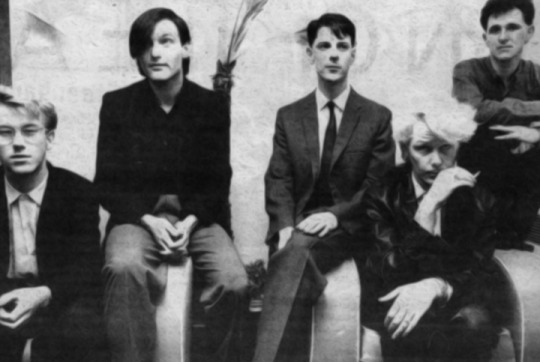
Clock DVA
youtube
Disc Three 1982-1984 features an early incarnation of Pulp with young Jarvis Cocker showing a glimpse of what the future held on “Everybody’s Problem”, the avant-jazz influenced “Intruder In The Dust” by Bass Tone Trap, In The Nursery’s industrial dance track “Iskra”, Tsi-Tsa’s single “Billingham’s Island” which sounds like Icicle Works straining to be the Bunnymen. Chakk’s “Out Of The Flesh” shows the influence of producers Cabaret Voltaire’s machine funk. Defective Turtles are more straight ahead on “Silicon Chip” with its pub rock guitars elevated by a jerky rhythm section and sax sound cribbed from X-Ray-Spex, both good.
As the decade progresses the music becomes both technically more proficient and sonically more sophisticated sacrificing a little of the energy and rawness to the polish. Scala Timpani’s “Winds of Change” is by no means bad just very much of it times with the slap bass, Linn drums and proggy keyboards, think Tears For Fears pre bombast. On the other hand, The Flight Commander’s “Message From A Dead Man” incorporates spoken word samples and middle eastern sounds into an atmospheric collage while The Anti Group gets gnomic and gnostic on “Zulu”. On “Like A Fool” Treebound Story, featuring Richard Hawley, produce a classic piece of indie pop and One Thousand Violins are sarky mid-1980s indie jangle of superior quality on their 1985 flexi-disc (ah memories) “You Ungrateful Bastard”, a track which deserves repeated plays.
youtube
Cherry Red has again given us a bonanza of carefully curated gems complete with a 60-page booklet of tales from the protagonists, photos and background essays about the Sheffield music scene. It’s a lot to digest but much to enjoy and many rabbit holes to delve into. Here’s hoping they are eyeing off Leeds.
Andrew Forell
#dreams to fill the vacuum#the sounds of sheffield#cherry red#andrew forell#albumreview#dusted magazine#post punk#industrial#punk#synth punk#indie#sheffield
8 notes
·
View notes
Text
A Very Merry Bollywood Romance: My Personal Favourites

I'm not going to say 'there's nothing like it' merely on account of the fact that I grew up immersed in watching hours upon hours of Bollywood fantasies, but rather because I can say with hand on heart that there's something about Indian cinema that really knows how to make you feel. I don't whether it's the oozing charisma and genuity of the actors; how passions and flavour is woven into every detail and gesture; whether it's the fact that your screen explodes with unapologetic culture and colour, or the way the music surges through you like wine through water. True, it can be ridiculously cheesy (to the point where I've even had to leave the room for cringing), but when it comes to mixing serendipity with the sensuous to equate with an experience of heart-rendering love, then honestly; nowhere but India can do finer.
This admittedly comes a little late after Valentine's day, however I was inspired to collab together some of my favourite Bollywood romances of all time (or at least the last twenty-two years) to share in the hopes of inspiring your next Netflix binge if you feel the itch to dive into something different (and better) than your usual rom-com agenda.
Khabi Khushi Khabie Gham (Through Smiles or Through Tears, 2001)

'If you want to be something in life, want to get something in life, or want to win something in life, then listen to your heart always. And if you don’t get any answer from your heart, then close your eyes; think of your mother and father's names, and see how you will reach your destiny, overcome all your hurdles. Victory will be yours. Only yours.'
You'd be hard pressed to find anyone in India who hasn't heard of this iconic number, this being India's answer to a cult classic like our own Bridget Jones or Notting Hill. Karan Johar's infamous blockbuster is a millennial Bollywood icon, and if you don't find yourself soaked in your own tears at least five times during the three-hour duration, then I would duly recommend getting your eye-ducts checked. And your conscience.
Khabi Khushi Khabie Gham (or KKKG as it is also affectionately known) is first on this list as it is as quintessentially Bollywood perhaps as it gets: entourages of lavish dance sequences and ornate cinematography, all the while underlined with emotional questions surrounding obligations not only to one's culture and home but moreover to one's self. It concerns the consequences of when Rahul (Shah Rukh Khan), adopted son of wealthy businessman Yash Raichand (Amitabh Bachchan), dares to forsake the perfectly selected match his father has picked for him for that of the exuberant Anjali (Kajol) from the lower-class sphere of Chandni Chowk. His choice in prioritising love over tradition and duty creates a fracture in the family dynamic over a span of ten years, this only finally being addressed when his younger brother Rohan (Hrithik Roshan) chooses to repair his broken family and reunite a dedicated mother (Jaya Bachchan) with her favourite son.
KKKG is one of my first choices whenever introducing newcomers to Bollywood as it would be difficult to find much to complain about with it. Yes it has its cheesy moments and a lot of the humour might require some cultural know-how, yet the comedy in question is so perfectly scripted that it doesn't detriment the moments of extreme emotionality - on the contrary, it positively amplifies it. I have additionally always had a soft spot for Anjali and Rahul as their relationship understandingly matures given the circumstances of their union, especially given Rahul's decision to move their small sect of their family out of India entirely. Regardless they still remain hilariously argumentative and flirtatious the whole way through, their more traditional relationship being paralleled through the younger and more westernised dynamic between Rohan and Anjali's younger sister, Pooja (Kareena Kapoor). The film is a package deal for all the emotions and a bonanza of some of the best acting talent in the industry, the love story being not just between one man and woman but towards one's home and family.
BEST SONG: Title Track
Mohabbatein (Love Stories, 2000)

'Love is like life; it's not always easy and it does not always bring you happiness, but if we do not stop living, then why should we stop loving?'
Now, Mohabbatein has a far more lavish layer of cheese slathered across it than the predecessor on the list, but that may be more down to how the cast is comprised of a camaraderie of newcomers alongside more the more accomplished acting masters. Mohabbatein is the story of three students who each fall in love whilst studying at the prestigious all-male college Gurukul under the lense of the strict headmaster Narayan Shankar (Amitabh Bachchan) - his most iron-clad rule bizarrely being that no-one is to pursue romantic relationships whilst under his roof for risk of immediate expulsion. Whilst all hope seems lost then for these horny *ahem* love-struck adolescents, enter the charismatic and emphatically romantic music teacher Raj Malhotra (Shah Rukh Khan). His presence at first seems innocent enough in his encouragement for the boys to nurture their affections as Robin Williams encouraged his own students in the pursuit of poetry, especially as it soon comes to light that Raj's own great love, Megha (Aishwarya Rai), committed suicide when her father expelled Raj when he learned of their relationship; determined that the two were not allowed to be together. That same father then being the unyielding Narayan Shankar.
Mohabbatein then makes for such brilliant cinema and engrossing romance as it combines all the freshness and innocence of young love with the intensity of passions that transcend the boundaries of life and death. The sense of pathos invoked by Chopra is interweaved into every detail of the piece, from music to performance; the preposterous and absurd. The confrontations between Bachchan and Khan in this piece are far more enigmatic than in KKKG given the different stakes between a father and son and the different types of love that two men can feel when grieving over the loss of the same woman. It proves one of my favourites time and again given how, for all the playfulness and somewhat ridiculous outlines in the plot, it is the eternalised love that is embodied by Raj and Megha, and the wondrous idea that not even mortality stands as a barrier between those that truly love each other, that will be hard pressed to feel like your heart might physically glow.
BEST SONG: Humko Humise Churalo / Zinda Rehti Hain Mohabbatein
Hasee toh Phasee (She smiles, she's snared, 2014)

'You are the oxygen to my double hydrogen. Our chemistry flows like water.'
This more modern film addresses far more contemporary issues than its predecessors, the complex relationship between Nikhil (Siddarth Malhotra) and Meeta (Parineeti Chopra) abandoning perhaps much of the traditional grandeur in place of what one could argue is closer to the standard quirky, slice-of-life style typical of an adolescent British rom-com. What is indisputable is that even without as much of a flair for the dramatic and the abundance of glamour, the film still radiates with a palpable sense of heart, as it invites us to explore what happens when flustered yet well-meaning Nikhil becomes saddled with looking after his fiancee, Karishma's, eccentric sister during the week before their wedding. One can't help but chuckle and squirm as we watch Nikhil's hapless attempts to pass Meeta off as a long-lost friend to his family and friends in his and Karishma's efforts to conceal her from her own family, the reasons for her freakish personality going unspoken except for the ominous pills she keeps popping on the sly.

We soon realise the reason Meeta has been isolated from her family is due to how she chose to prioritise her academic ambitions over that of the traditional femininity and getting dolled up for the purposes of marriage and domesticity; the disappointment invested towards her paving a way for a natural connection with an equally lost Nikhil in his endless efforts to appease the incessant demands of his more materialistic fiancee. This then is what makes the film even more compelling given how it goes against the culturally ingrained stereotypes of the man managing to be the effortless, seductive hero, able to provide and fight for the woman he loves in conjunction to the beauteous and elusive heroine. Instead, it invokes a relationship about two people who feel lost in the oppression of society's expectations, the result being that despite judgemental relatives and unstable emotionality, the two are able to find something magical that can only be brought out in each other.
BEST SONG: Ishq Bulaava / Manchala
Pardes (Foreign Land, 1997)

'You've all mistaken me for some innocent little painting that you've framed in gold, and now you want me to hang on these walls in silence and become a part of this false decor! This isn't the dream I came to this foreign land with, is it?'
Now, this is a controversial one. Pardes is probably the most politically charged movie on this list as it is famous for being an incredibly evocative piece of anti-Western propaganda. It concerns what happens when free-spirited Ganga (Mahima Chaudhary) is handed in marriage to the son of a wealthy NRI (Non-Resident Indian), however the vastness of the difference in culture on top of the distance between India and America sees to it that the outcome of such an engagement comes to some horrific consequences. Pardes is primarily then about the clash between cultures when the innocent essence of India is dragged to and exposed within the more confident and lavish shores of America. This premise in itself may seem problematic and would understandably evoke outrage as America is intentionally built up as the criminalised empire in the face of the all-pure India, however, what the viewer must remember when watching Pardes is that it is quintessentially a story about consent and respect. It's about acknowledging the difference in cultures and adhering to ways of life you may not understand, rather than trying to overwhelm and consume that sense of 'otherness' like a tyrannical Frankenstein 'penetrating into the secrets of nature' and causing chaos for everyone. It is fair to say then that Pardes is problematic and the socio-political accuracy of the piece could be spat upon until the cows come home, but it is this sense of duality and complication that makes it so interesting.
The main romantic storyline of the film then may be more of a Trojan horse for the more significant aspects for discussion, but it is more than fair to say that the political stakes are squarely matched by the passions at play. After all, when the wholly Americanised Rajiv (Apurva Agnihotri) proves to be more than a little bit of a disappointment, it is the relationship between Ganga and his adopted brother Arjun (Shah Rukh Khan) that comes to full heart-warming fruition. Arjun's role as the mediator between Ganga and Rajiv in trying to fulfil his adopted father's wish in smoothing the match over quickly escalates to into him becoming Ganga's most trusted confidante and defender. One can recognise perhaps the outdated sense of chivalry in this - especially as the inclusion of the attempted rape scene does appear to be an excuse for tensions to culminate in a traditional, Bollywood-esque full-on fist fight. However, credit has to be duly cast to the writers as they characterise Arjun as possessing a rare sense of compassion and empathy, especially given how his proclamation of love for Ganga is based not on lust but his genuine desire to trust, revere, respect and protect. In addition to this, it is easy to admire Ganga for her perseverance in trying to navigate this foreign land, she becoming all the more engaging for her burgeoning determination without the expense of her self-respect and ingrained love for her home nation. The prioritisation of one another's welfare above their own alongside becoming embroiled in their sense of duty to tradition and family is then what makes their journey towards each other so compelling and heart-wrenching. Pardes is a love story with incredibly heavy undertones that would have to be entered with a particularly open mind, but perhaps once the offences have been fully digested, one can fully appreciate why the film is so renowned; with a love that is all at once devastating as it is wonderful and profound.
Devdas (2002)
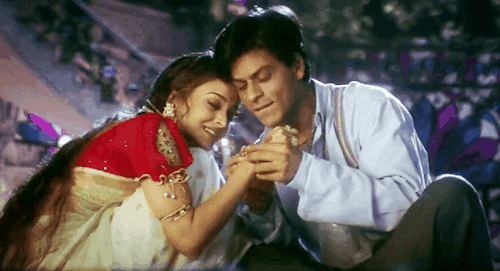
'Where can I find again my lost innocence? My lost dreams? My lost childhood? What happened to my home in the shade of the trees?'
If there was ever an answer to the intensity and literary grandeur of tragic romances the like of Romeo and Juliet or Abelard and Heloise, then Devdas slaps back with unparalleled panache. If it wasn't a love story in its own right then Devdas is indisputably an affair for the senses; Sanjay Leela Bhansali's breath-taking production instilling every scene and action with such aestheticism that the Pre-Raphaelites are, no doubt, positively quaking. The story is no doubt a tragedy, following the titular character's (Shah Rukh Khan's) debilitating descent into alcoholism following his childhood sweetheart, Paro's (Aishwarya Rai), marriage after his mother ridicules her family for being descended from prostitutes a long time back down the line of their ancestry. Ironically enough, he seeks relief in leaving his home and taking shelter with a friend who works at a brothel, his emotional deterioration subject to the fruitless effortless of the heartfelt taiwaif (courtesan) Chandramukhi (Madhuri Dixit).

The relationship between Dev and Paro is continuously fraught with psychological manipulation as the two try to progress with their lives whilst undeniably in love with each other, the acting on the parts of Khan and Rai being so invigorating that it would not be surprising to find yourself holding your breath whenever the two are on screen. the interactions between Khan and Dixit are additionally moving as they have a deeper understanding of one another, their relationship perhaps being all the more rueful in the sense of it being a one-sided sense of self-sacrifice as Dev continues to ruminate over a love he can never have. Indeed, though Khan is typically praised for his rigorous performance, it has been disputed that it is perhaps the talent and dynamic between Rai and Dixit in their roles as Paro and Chandramukhi - the aristocrat and the courtesan - is the actual showstopper in this magnificent piece. It was never in the original story after all that the two women should have a relationship outside their original and comparatively brief confrontation over who loves Dev more, so that fact that Bhansali chooses to instal and flesh out the friendship between these two equally fierce and magnetic women is but one of the aspects that makes this film so essential and inspiring.
BEST SONG: All of them omg
Goliyon ki Rasleela Ram-Leela (A Play on Bullets: Ram-Leela, 2013)
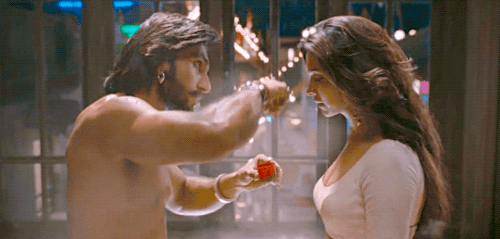
'If hatred and pride can make a desert of the sea, then love can make flowers bloom here.'
Let's establish this from the start - Baz Luhrmann can choke.
This is how a real Rom-and Jules-adaption is done. As the most sultry addition to the list by far (seriously, phew), Ram-Leela admittedly does take a lot of liberties with the narrative. Nevertheless, any alterations or revisions that have been made are entirely for the better. In fact, even if you were to take the stance that Romeo and Juliet were as young and naive as they are in order to heighten the tragedy of violence and conflict, then it becomes more than reasonable to argue that Ram-Leela actually captures the essence of the play more than the stagnant Western replicas that have plagued us in the past. We still have the warring families, the star-crossed lovers and poetics on steroids, only that the narrative is enhanced by the rawness of rural Rajasthan to bring Shakespeare’s message to better fruition. Indeed, if you, like me then, have always been able to appreciate the ideologies behind the original play, yet remained impatient with the immaturity and implausibility of the titular characters in spite of yourself, then Ram-Leela provides the perfect amendment to all those irritations. Instead, we see two leads who are far more enthralling and philosophical, the opposition between them being so devastating given how Bhansali interweaves dramatic irony with frustrating relish. It comes down to how the Rajadis and Saneras cause the original Montagues and Capulets to look embarrassingly spineless by comparison; their inconceivable prowess in being able to manipulate even their own playing on our expectations so much that it cements the romance firmly within the boundaries of tragedy.
Indeed, we are not just treated to a brief separation between the two until the time of death, but rather the stage is reset so that Ram (Ranveer Singh) and Leela (Deepika Padukone) become the respective heads of their families and are forced to war against each other - and not entirely against their own wills either. The film encompasses a similar sense of passionate antagonisation that abounds in Devdas as well then, the irony being that the more fraught and frayed the relationship, the more your heart aches for want of the forsaken lovers to be able to make it. In truth, the film actually starts out ridiculously playfully with bounties of energy and innuendo, the fact that it is able to convincingly transition on its axis to become so emotionally straining being a credit to Bhansali's directorial ingenuity. Of course, the chemistry between the leads in Ranveer Singh and Deepika Padukone is near indescribable, both balancing refreshing elements of mischief and charm alongside intense vulnerability and ardour. Critics have labelled their performances as probably being still the finest of their careers (which is saying plenty, trust me), the camaraderie between the two hardly being surprising. After all, the two did just get married late last year - and on the anniversary of the film's original release date no less! So if that doesn't convince you of the quality of such a love story, then I'm afraid that you will be convinced by very little else.
BEST SONG: Lahu Munh Lag Gaya / Nagada Sang Dohl / Laal Ishq
Kal Ho Naa Ho (Tomorrow might not be, 2014)

'Listen - live, be happy, smile, because who knows? Tomorrow might not be.'
Honestly, in light of all the films that have been listed before now, with their mind-blowing cinematography, incredibly moving soundtracks and ground-breaking scopes of acting, Kal Ho Naa Ho might seem to fall a little short. It's set in the dreary din of New York, the soundtrack is more constructed towards fun and contemporary glamour, yet it is undeniable that this film is my favourite of the whole bunch. The top of my list of romantic Bops then is the story of Naina (Preity Zinta) and the many complications which taint her family; the pressure being so much that she has been rendered the constant embodiment of irritability. And even forgotten how to smile. Everything turns around when Aman (Shah Rukh Khan) enters the family's life: optimistic, charismatic and caring, he literally breathes new life into Naina's existence, so that before long she finds herself completely devoted to him in place of the unspoken affections of her closest friend, Rohit (Saif Ali Khan). What pans out is that on the verge of telling Aman she loves him however is that he tells Naina that the reason he came to New York was to repair his frayed relationship with his wife, Priya (Sonali Bendre). Unbeknownst to the bereft Naina, this is, in fact, a lie. The truth is that Priya is actually Aman's doctor and he doesn't have much time left to live.
I don't know then whether it's because the characters and scenarios are so well grounded, the dynamics and difficulties within the Kapur family are more relatable, or that the relationships between and constructions of characters are perhaps the most believable, but it's one of those films that you'll agree, once you've watched it, has an inexplicable sensibility that takes the cake every time. A lot of it does seem to be grounded in the healthy and brilliant way the love triangle is handled in the film, as any sense of complication or rivalry between Rohit and Aman is evoked as comedy rather than any serious resentment or envy. It's an incredibly unique love triangle then and this is perhaps why it has garnered so much critical respect, as the love-triangle motif is such a typical motif of Bollywood cinema (with repeatedly toxic and violent confrontations like in Pardes), that it is refreshing to see a love depicted so genuinely and platonically. It's even more heart-warming to watch as Aman does his best efforts to ensure that Naina walks with Rohit down the aisle (or the Saptapadi to be precise) all the while wielding his best façade so that she never realises that he loves her too. In fact, the affections between them are so subtle and few that the effect is paradoxically more intense, as you find yourself latching onto every fleeting sign of love between them that you can. KHNH then is another one that I recommend first and foremost, though in truth it's best not to watch it too often unless you have a few days to spare in which to emotionally recover.
BEST SONG: Titular track
And there you have it - they may not be the best according to everyone's taste, but the romances listed above are some of the most critically acclaimed and effective Bollywood masterpieces to ever grace the silver screen. Though they may start as cliched and melodramatic, with too much dance and quirky dynamic, this is always a foil to deep-rooted passions and die-hard affections - each a romantic experience above and beyond any of your expectations.
Tanika Lane
11 notes
·
View notes
Note
hi!!! can you make tv shows recs? i just finished black sails and i need something equally incredible
I wanna be like [KICKS YOUR DOOR DOWN] because I love this shit, but YOU kicked MY door down, so, YEAH, I CAN MAKE A TV SHOW REC!!! I’m gonna limit myself to my top 4 (Black Sails being in my top 5) so you know how serious I am. I am so serious. hokay.
- HANNIBAL - it’s like Black Sails in that it’s INTENSE AS ALL HELL, intelligent, and very much about people. it’s unlike Black Sails in that it’s modern, it’s a psychedelic crime drama, and there’s only one tiny scene in which someone sails across an ocean. the character development on all fronts is unparalleled – I’ve never seen anything like Will Graham’s journey in this show and I probably never will again (until someone picks up Hannibal for season 4). it’s my favourite show, and it’s one of the best – it’s funny, batshit, gorgeous, and the twists, reveals, finales, acting, clothes, faces, and single choice of Actual music that isn’t bing bong baaannngg are all exquisite. also: heterobaiting with a queer endgame (TIMES TWO. WE GOT LESBIANS!). holla. (3 seasons, ended… for now.)
- JUSTIFIED - it’s like Black Sails in that it’s AMAZING. it’s unlike Black Sails in pretty much every other area. it’s an unlikely candidate for one of my favourite shows of all time, as it is a very mainstream-appeal bonanza about a US Marshal from Kentucky and a bunch of small-time crime lords. BUT, it has 99.9% of things I love in tv shows: indescribable (!!!!) dialogue, Characters (with a capital C), shrouded and compelling backstories all round, Timothy Olypant, characters with History, amazing women, endless flanter (flirty banter), and so! much! to say! not to mention the single greatest background character in the history of anything (QUITE LITERALLY modern-day Hoosier from The Pacific) was confirmed gay af by the showrunner. 10/10. (6 seasons, ended.)
- KILLING EVE - another one that’s amazing and queer like Black Sails, unlike Black Sails in every single other way. there’s only been 8 episodes of this show and it’s in my top 5 – do I need to say anything else to sell it? MI5 agent (played by SANDRA FRIGGIN’ OH) chases after a prolific assassin (played by JODIE COMER, SNEAK ATTACK). prolific assassin sees Sandra Oh and, understandably, falls head over heels in love. Sandra Oh sees prolific assassin and, understandably, becomes fully 2012-era Twilight #robsessed. hilarious supporting cast, Fiona Shaw being Primo Fiona Shaw, killer writing, and so many clothes. if you love spy dramas but ALSO get hot for Miu Miu and Dries Van Noten suits, it’s the show for you. Sandra Oh and Jodie Comer are such incredible actresses that even if you don’t like any of the things I just talked about, you should watch it anyway. it’s gonna be one of those shows that you need to watch to seem cool at work. just saying. (8 eps. get on it.)
- IN THE FLESH - my precious, niche baby. like Black Sails: stunning, queer, anti-establishment. unlike Black Sails: everything else. I struggle to describe this show to people without a) getting choked up, b) waxing lyrical, and c) quoting W. B. Yeats. bare bones explanation: post-zombie apocalypse England, the zombies (ahem, Partially Deceased Syndrome sufferers) have been treated and are being integrated back into society. I’m… not even kidding when I say I think this show should be studied. it’s about prejudice and fear of the unknown, it’s an allegory for queerness, mental illness, the AIDS crisis, people coming home from prison. the characters with PDS are murdered, ostracised, fetishised, radicalised. it’s frightening because it’s such a realistic reflection of England. plus it’s great that it doesn’t do the whole “It’s A Metaphor For Gay People And Mentally Ill People (:” thing using a bunch of regular heterosexuals. do yourself a FAVOUR. (2 seasons, ended.) (I’m still mad about it.)
#HANNIBAL JUSTIFIED AND KILLING EVE ARE ALL ABOUT LAW ENFORCEMENT OFFICERS HAVING INAPPROPRIATE RELATIONSHIPS WITH CRIMINALS#HAVE WE FOUND... MY JAM?#answered#can't believe I have to watch all of In The Flesh again#oh no! what a chore!
109 notes
·
View notes
Text
William Marshall



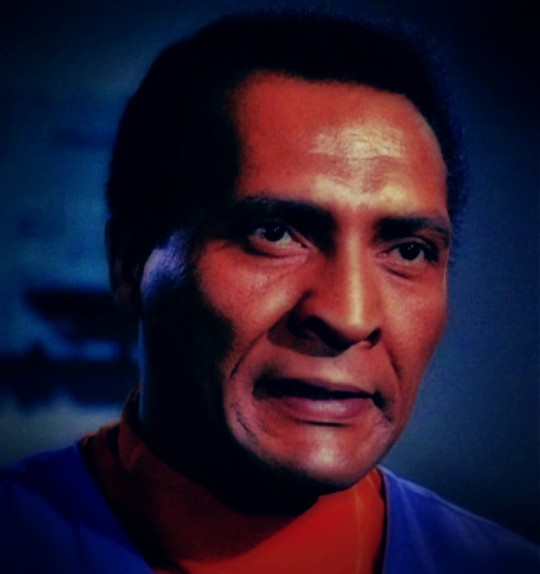
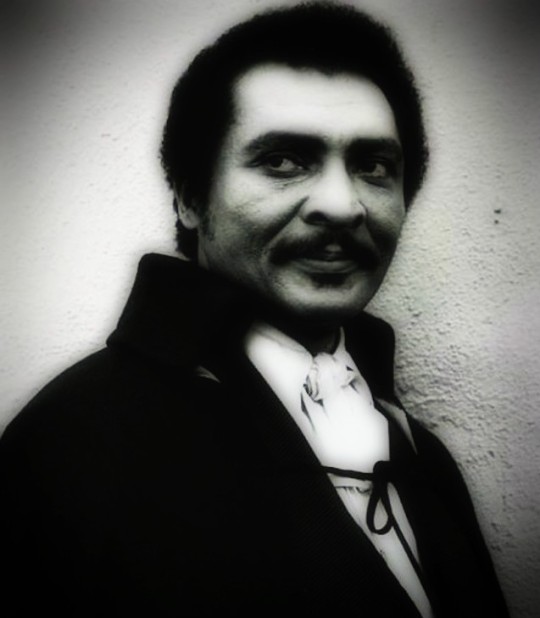
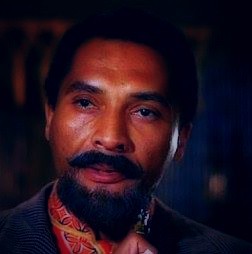
William Horace Marshall (August 19, 1924 – June 11, 2003) was an American actor, director, and opera singer. He is best known for his title role in the 1972 blaxploitation classic Blacula and its sequel Scream Blacula Scream (1973), as the "King of Cartoons" on the 1980s television show Pee-wee's Playhouse beginning with its second season, and an appearance as Dr. Richard Daystrom on the original Star Trek television series. He had a commanding height of 6 ft 5 in (1.96 m), as well as a deep bass voice.
Biography
Early life and career
Marshall was born in Gary, Indiana, the son of Thelma (née Edwards) and Vereen Marshall, who was a dentist. He attended New York University as an art student, but then trained for a theatre career at the Actors Studio, at the American Theatre Wing, and with Sanford Meisner at the Neighborhood Playhouse.
He made his Broadway debut in 1944 in Carmen Jones. Among his many other Broadway appearances, he understudied Boris Karloff as Captain Hook in Peter Pan in 1950, then played the leading role of De Lawd in the 1951 revival of The Green Pastures (a role he repeated in a BBC telecast of the play in 1958). He performed in Shakespeare plays many times on the stage in the United States and Europe, including the title role in at least six productions of Othello. His Othello (which was later captured in a video production in 1981), was called by Harold Hobson of the London Sunday Times "the best Othello of our time," continuing:
...nobler than [Godfrey] Tearle, more martial than [John] Gielgud, more poetic than [Frederick] Valk. From his first entry, slender and magnificently tall, framed in a high Byzantine arch, clad in white samite, mystic, wonderful, a figure of Arabian romance and grace, to his last plunging of the knife into his stomach, Mr Marshall rode without faltering the play's enormous rhetoric, and at the end the house rose to him.
Marshall even played Othello in a jazz musical version, Catch My Soul, with Jerry Lee Lewis as Iago, with Center Theatre Group at the Ahmanson Theatre in Los Angeles in 1968.
He also portrayed the roles of Paul Robeson and Frederick Douglass on stage . Marshall had researched Douglass' life for years and portrayed him on television in Frederick Douglass: Slave and Statesman, which he co-produced in 1983.
Film and television career
Marshall's career on screen began in the 1952 film Lydia Bailey as a Haitian leader. He followed that with a prominent role as Glycon, comrade and fellow gladiator to Victor Mature in the 1954 film Demetrius and the Gladiators. His demeanor, voice and stature gave him a wide range, though he was ill-suited for the subservient roles that many black actors of his generation were most frequently offered. He was a leader of the Mau-Mau uprising in Something of Value (1957), and Attorney General Edward Brooke in The Boston Strangler (1968). He probably received the most notice for his role in the vampire film Blacula and its sequel Scream Blacula Scream. In later years, Marshall played the King of Cartoons on Pee-wee's Playhouse, replacing actor Gilbert Lewis, during the 1980s. (The character's catchphrase "Let...the cartoooon...begin!" became immensely popular.)
In the early 1950s, Marshall starred briefly in a series about black police officers, entitled Harlem Detective. The show was canceled when Marshall was named as a communist in the anti-communist newsletter Counterattack.
Despite the blacklisting because of his supposed communist connections, Marshall managed to continue appearing in both television and films. In 1962, Marshall appeared on the British spy series Danger Man in the episode titled "Deadline" and in 1964 Marshall played the role of travelling opera singer Thomas Bowers on the Bonanza episode "Enter Thomas Bowers." Additionally in 1964, he appeared, with actor Ivan Dixon, as the leader of a newly independent African nation and as a T.H.R.U.S.H. agent in the first-season episode of The Man from U.N.C.L.E. entitled "The Vulcan Affair". In 1968 he appeared as Dr. Richard Daystrom in the Star Trek episode "The Ultimate Computer". In 1969, he had a special guest appearance as the character Amalek in an episode of The Wild Wild West entitled "The Night of the Egyptian Queen".
He also won two local Emmys for producing and performing in a PBS production, As Adam Early in the Morning, a theatre piece originally performed on stage. He also was featured in an episode of The Alfred Hitchcock Hour titled, "The Jar", with actors Pat Buttram and George Lindsey.
Later life and death
In addition to acting and producing, Marshall taught acting at various universities including the University of California, Irvine, and the Mufandi Institute, an African-American arts and music institution in the Watts section of Los Angeles. He did similar work at Chicago's ETA Creative Arts Foundation, which in 1992 named Marshall one of its Epic Men of the 20th century.
For 42 years, Marshall was the partner of Sylvia Gussin Jarrico, former wife of blacklisted screenwriter Paul Jarrico. Marshall died June 11, 2003, from complications arising from Alzheimer's disease and diabetes. He was survived by sons Tariq, Malcolm, and Claude Marshall and daughter Gina Loring. Eulogists at his funeral included Sidney Poitier, Ivan Dixon, Paul Winfield, and Marla Gibbs.
Marshall was considered by many to be a much underrated actor and one who never got his due. Some have remarked that Marshall should have had a much more successful and larger screen career, even saying that Marshall would have been a perfect choice for the role Thulsa Doom in Conan the Barbarian.
Filmography
Lydia Bailey (1952) - King Dick
Demetrius and the Gladiators (1954) - Glycon
Something of Value (1957) - Leader - Intellectual in Suit
Sabu and the Magic Ring (1957) - Ubal, the genie
La fille de feu (1958) - Stork
Piedra de toque (1963) - African Missionary (uncredited)
To Trap a Spy (1964) - Sekue Ashumen
The Hell with Heroes (1968) - Al Poland
The Boston Strangler (1968) - Atty. Gen. Edward W. Brooke
Skullduggery (1970) - Attorney General
The Mask of Sheba (1970) - Captain Condor Sekallie
Zig Zag (1970) - Morris Bronson
Honky (1971) - Dr. Craig Smith
Blacula (1972) - Blacula / Mamuwalde
Scream Blacula Scream (1973) - Blacula / Mamuwalde
Abby (1974) - Bishop Garnet Williams
Twilight's Last Gleaming (1977) - William Klinger - Attorney General
The Great Skycopter Rescue (1980) - Mr. Jason
Vasectomy: A Delicate Matter (1986) - Dr. Dean
Amazon Women on the Moon (1987) - Pirate Captain (segment "Video Pirates")
Maverick (1994) - Riverboat Poker Player
Sorceress (1995) - John Geiger
Dinosaur Valley Girls (1996) - Dr. Benjamin Michaels (final film role)
Wikipedia
8 notes
·
View notes
Photo

Rush Limbaugh Legacy
(Putting the Con in Conservatism)
by Stephen Jay Morris
02/20/21
©Scientific Morality
For those who are Jewish or Catholic and feel guilty about rejoicing over a human’s death, if God truly exists, then it doesn’t matter whether you just think it or say it aloud: God can hear whatever you are thinking. So, knock yourself out! As for me, I am Agnostic. The way I see it, Rush Limbaugh cannot see or hear you: he’s dead. Do you think that Rush didn’t celebrate when Castro died? Well, while Rush was puffing away on those fat Cuban cigars, Castro got the last laugh because Rush got cancer! You see? The communists will sell tobacco to the capitalists so that they can get cancer.
How do I feel now that Rush has kicked the bucket? Absolutely nothing! Am I a sociopath? Nope. Am I a narcissist? Please! I knew that Rush was a phony from the git go. The fact of the matter is, Rush was a lowly disc jockey from California; he was not political at all! His favorite topics were young chicks and lot’s of food. Like Trump, the only thing he cared about was money. Lots of money! And he knew he was not going to make stacks of cash by spinning those awful records from the 70’s.
I found it hilarious that some people viewed him as a Conservative icon. Also like Trump, he was a draft dodger who got off for some medical deferment. Alas, Rush had a rich daddy who bailed him out! It’s funny how these vehement anti-communists always have others fight against the thing they hate.
Let’s review radio history. By the 90’s, radio was slowly dying. Kids were getting their music elsewhere—over their iPods and via Napster downloads. Commuters would listen to music during their weekday drives to and from work. Baby Boomers and some Gen Xers would occasionally listen to the radio.
THEN came Howard Stern out of New York, via the advent of “morning zoo shock radio.” Stern started that format and had a ratings bonanza that saved radio from its demise. Filled with sex, racial humor, insults at Hollywood celebrities, and self defacing jokes, people endlessly devoured all that naughty stuff!
It was then that Rush appeared. Only, his shtick was in being an asshole. His humor rode on the concept of pushing an old lady in a wheelchair down the stairs. And, so, his format began hate radio. Being the selfish cunt that he was, he couldn’t have cared less about the poor and the sick. In the USA, you have millions of angry, white guys to exploit, so what do you do? Make fun of the sick and poor! Rush garnered high ratings through verbal manipulation and coded speech. Once that tore it, his show got syndicated all across the fruited plains over low power, AM stations. His advisers told him to identify with the political Right for more listeners. He did just that. You see? Rush was no Conservative, he just played one on the radio.
One gimmick he employed was to mock vegetarians and vegans by eating a plate full of hamburgers on the air. It was so fucking annoying listening to him munch and smack his big mouth on the radio! He’d often brag about the big, juicy steaks he claimed to have eaten at his favorite restaurants. Allegedly, he had a heart attack, but kept it secret for years. Being the fake Conservative he was, his scapegoats were women, Blacks, Jewish Liberals, Hollywood actors, animals, the environment, health food, and other, so-called Left wing stuff.
Boom! He became rich and famous. His biggest dream was to be a playboy while smoking a big cigar and playing golf. He passed himself off as a loyal Republican, and many Right wing politicians courted him for photo ops. Essentially, Rush used the political Right for his own amusement.
If any of this sounds way too familiar, well that’s because he greatly influenced one very famous, trust-fund kid: Donald J. Trump. And, since Trump has the creativity of a knat, he imitated Rush. You recall all the bragging that Trump did? Well, Rush was doing it far earlier. He frequently bragged about his huge ratings and all the money he had. After all—“Excellence in Broadcasting”—was the name of his broadcasting company.
After a time, things went downhill for him. Howard Stern made fun of him on the air. He got addicted to Oxycontin. He traveled to foreign countries for sex, some of which was alleged to have been with underage girls. He couldn’t keep a wife—which, for some reason, is a common occurrence for talk radio guys.
After five years on the air, I stopped listening to him. So many clones of him were on the radio by then, all with their own styles, but cheap imitations of Rush. I thought Rush had quietly retired and left the airwaves. And then, I tuned into a local radio station and THE OLD CHUD was still on the air! This kind of thing underscores a primary problem with egotists: their ego needs constant stimuli, or they simply rot and die.
How will history judge Rush Limbaugh? The same way that it judged Father Charges Coughlin. The only people who will remember Rush are college historians. Oh, the irony! The guy routinely attacked so-called Left wing colleges and universities, yet the only ones who are likely to generate any interest in him are professors of higher learning!
His was another tragic American story. It’s not Satan that makes people evil; it is an unhealthy and unchecked ego.
0 notes
Text
5 Things You May Not Know About Horror Icon Vincent Price
New Post has been published on https://nofspodcast.com/5-things-may-not-know-horror-icon-vincent-price/
5 Things You May Not Know About Horror Icon Vincent Price
Vincent Price is a name recognized by many, most often for his contributions to 20th century horror cinema. Coming onto the Hollywood scene in Service de Luxe (1938), Price distinctive nasally tone of voice and his tall stature were key in his becoming so popular as a character actor. 1944’s Laura paired him with Gene Tierney, and from there Price soon became rather sought-after in Tinseltown. Although his first horror picture was a minor role in 1938’s Tower of London, starring Boris Karloff, he really broke into horror with 1953’s House of Wax. The man’s life has been the subject of many a documentary and biography, and today we’re counting down the top 10 most interesting facts about a very interesting man.
5. Birthday Bonanza
From left to right: Peter Cushing, Christopher Lee, John Carradine, Vincent Price. Photo taken on the set of House of the Long Shadows (1983).
As a very perceptive nun in a famous musical once said, “Let’s start at the very beginning; A very good place to start.” Vincent Leonard Price Jr. was born on May 27, 1911, in St. Louis Missouri. (A town which, by the way, honored the man with a star on the St. Louis Walk of Fame for his cinematic contributions.) However, he’s not the only famous mid-century horror star who was born within that time frame. As it turns out, Price shares a birthday with fellow horror alum Christopher Lee, who was born on the same day in 1922.
As if the fates themselves hadn’t already aligned there, yet another famous horror actor of the era, Peter Cushing, was born one day earlier, on May 26, 1913. The three teamed up on the screen in a few different films, including Scream and Scream Again (1970), and 1983’s horror parody House of the Long Shadows (where they were joined by John Carradine!).
4. Kitchen Connisour
Price in the kitchen! (Mid-1980s)
One of Vincent Price’s greatest passions was gourmet cooking. He even had his own cooking show in 1971 on British TV! The show was called Cooking Price-Wise, named after his final cookbook. And yes, you heard me correctly. Cookbook. Price published four cookbooks during his lifetime, all of which were co-authored with his second wife, Mary Grant Price. Those were, in order: A Treasury of Great Recipes (1965), Mary and Vincent Price present a National Treasury of Cookery (1967), Mary and Vincent Price’s Come into the Kitchen Cook Book: A Collector’s Treasury of America’s Great Recipes (1969), and the aforementioned Cooking Price-Wise with Vincent Price (1971).
In addition to his short-lived television show, Price also once had a guest spot on The Tonight Show with Johnny Carson, during which Price taught Carson (and the audience) how to poach a fish in a dishwasher!
3. Vamoosed Vocals
Vincent Price and some Disney employees prepare to record the ill-fated narration for Phantom Manor.
In the late 80s and early 90s, Disney was developing a park in France that would attempt to replicate the success of their American theme parks. But one ride in particular seemed destined for greatness from the start, that being a ride based on Disneyland’s very successful Haunted Mansion called Phantom Manor. And the star of the show? A narration by none other than Vincent Price himself! The Imagineers whipped up an attraction script meant to be performed by Price, Price recorded it, and all seemed according to plan. Until French officials informed the Walt Disney Company that most of the ride’s audio had to be in French. Price’s narration was ultimately scrapped, and replaced after a few weeks of operation by a French narration, recorded by Gérard Chevalier.
Price’s scrapped narration for Phantom Manor can be heard in its entirety on the 1999 CD The Haunted Mansion – 30th Anniversary. But the only contribution of Price’s that can be heard in the attraction proper to this day is arguably Price’s most distinctive vocal feature: His famous cackling laugh.
2. Art Appreciation
Vincent Price admires a painting. (1960s)
Price studied Art History at Yale, and his own private collection of art was certainly something to be seen. Despite this, he was no stingy collector. Sears department stores across the Unites States sold from the “Vincent Price Collection of Fine Art”, selling to the public pieces of fine art they might not have been able to amass themselves. Price and his second wife, Mary Grant Price, donated a massive amount of money and art from their private collection to East Los Angeles College. Today, the Vincent Price Art Museum is still a vital source of art education. The Museum’s mission statement, according to their website, “is to serve as a unique educational resource for the diverse audiences of the college and the community through the exhibition, interpretation, collection, and preservation of works in all media of the visual arts.”
He was even appointed to the Indian Arts and Crafts board during the Eisenhower administration. Vincent Price’s daughter, Victoria, once said that Price’s mission in both teaming up with Sears and in donating so much to form the Vincent Price Art Museum was to, “bring art to the American public.” He certainly accomplished that much.
1. Political Personality
youtube
Price was very outspoken about his left-leaning political views. It was no secret that Price felt very strongly about these issues, and he had absolutely no problem letting anybody know that he had hard opinions on the things going on in the world during his lifetime. Along with being vocally supportive of both his lesbian daughter, Victoria, and his bisexual wife, Cora Browne (and quite possibly having been bisexual himself), Price vocally criticized Anita Bryant’s anti-gay propaganda, and appeared in public service announcements which attempted to educate the public about the AIDS virus. But besides his stance on LGBT issues, Price was also a firm believer in anti-racism and anti-religious discrimination.
I think an appropriate way to end this article would be by linking you to an audio clip from the conclusion of a 1950 episode of the popular radio show The Saint. In it, Price outlines a moral philosophy that seems shockingly relevant today. You can listen to the speech in the video linked above, or read it below. Either way, it was very clear that the late, great, Mr. Price was much more than just a hokey horror actor.
Ladies and gentlemen, poison doesn’t always come in bottles. And it isn’t always marked with the skull and crossbones of danger. Poison can take the form of words and phrases and acts: the venom of racial and religious hatred. Here in the United States, perhaps more than ever before, we must learn to recognize the poison of prejudice and to discover the antidote to its dangerous effects. Evidences of racial and religious hatred in our country place a potent weapon in the hands of our enemies, providing them with the ammunition of criticism. Moreover, group hatred menaces the entire fabric of democratic life. As for the antidote: you can fight prejudice, first by recognizing it for what it is, and second by actively accepting or rejecting people on their individual worth, and by speaking up against prejudice and for understanding. Remember, freedom and prejudice can’t exist side by side. If you choose freedom, fight prejudice.
#actors#classic horror#cora browne#countdown#fun facts#horror#horror 2017#horror actor#horror film#horror legacy#horror legends#horror movie#horror movies#horror news#horror podcast#horrorfan#horrorfanatic#horrorfiend#horrorfilm#horrormovie#horrormovies#horrors#list#mary grant price#top five#victoria price#vincent price
2 notes
·
View notes
Photo

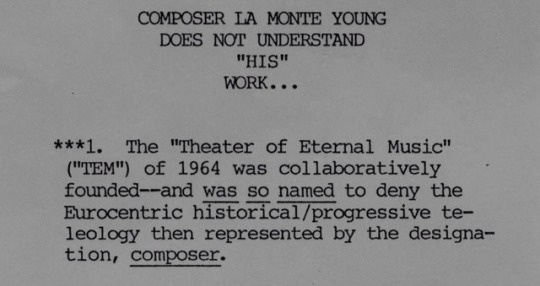
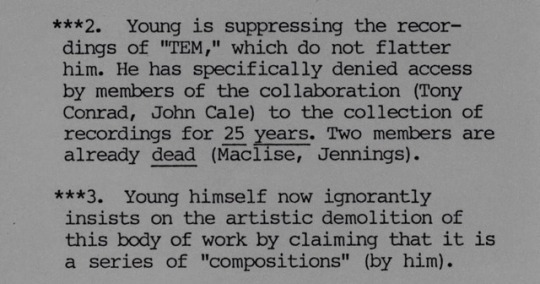

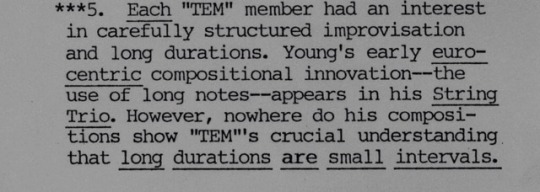
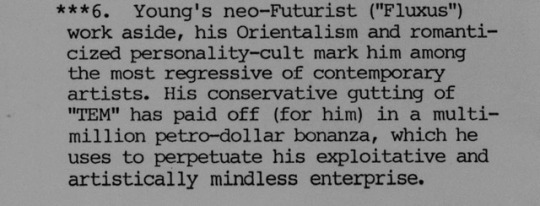
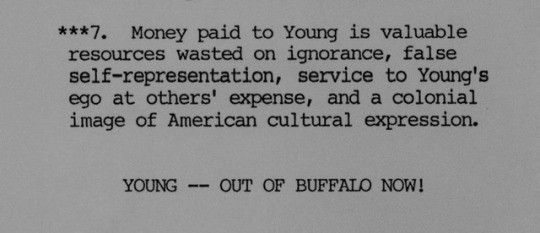
Tony Conrad standing outside a concert by La Monte Young in Buffalo with a picket sign declaring “Composer La Monte Young does not understand ‘his’ work”, 1990.
COMPOSER LA MONTE YOUNG DOES NOT UNDERSTAND “HIS” WORK …
Tony Conrad / 1990
1. The “Theater of Eternal Music” (“TEM”) of 1964 was collaboratively founded - and was so named to deny the Eurocentric historical/progressive teleology then represented by the designation, composer.
2. Young is suppressing the recordings of “TEM,” which do not flatter him. He has specifically denied access by members of the collaboration (Tony Conrad, John Cale) to the collection of recordings for 25 years. Two members are already dead (Maclise, Jennings).
3. Young himself now ignorantly insists on the artistic demolition of this body of work by claiming that it is a series of “compositions” (by him).
4. The “TEM” introduced an influential preoccupation with just intonation. “TEM” was anti-rationalist and non-electronic, but did focus on perceptual and conceptual aspects of small intervals. Young himself misunderstands this development as neo-Pythagorean rationalism (after the scientific idealism of Helmholtz).
5. Each “TEM” member had an interest in carefully structured improvisation and long durations. Young’s early eurocentric compositional innovation - the use of long notes - appears in his String Trio. However, nowhere do his compositions show “TEM”’s crucial understanding that long durations are small intervals.
6. Young’s neo-Futurist (“Fluxus”) work aside, his Orientalism and romanticized personality-cult mark him among the most regressive of contemporary artists. His conservative gutting of “TEM” has paid off (for him) in a multimillion petro-dollar bonanza, which he uses to perpetuate his exploitative and artistically mindless enterprise.
7. Money paid to Young is valuable resources wasted on ignorance, false self-representation, service to Young’s ego at others’ expense, and a colonial image of American cultural expression.
YOUNG -- OUT OF BUFFALO NOW!
#tony conrad#la monte young#john cale#theater of eternal music#minimalism#avant garde#picketing#picket sign#1990#protest#demonstration#art protest#manifesto
94 notes
·
View notes
Text
Edinburgh’s Fringe, Now 70, Is Having Growing Pains
By Rod Nordland, NY Times, Aug. 21, 2017
EDINBURGH--Once a year the cobbled, medieval streets here host an extra million people, tripling the population of the Scottish capital for the nearly monthlong Edinburgh Fringe Festival, which used to be known as the biggest theater festival in the English-speaking world.
Now in its 70th year, the event has become the largest arts festival of any kind in the known world, topped in attendance, its organizers say, only by soccer’s World Cup or the Olympics.
The Fringe--taking place this month--began as a protest against the inaugural state-subsidized, highbrow Edinburgh International Festival after eight performers who were refused permission to perform there in 1947 started their own event. Many say it has stayed true to its anti-establishment roots. The theme this year, for example, is “Art as an act of defiance.”
But others say it has become too big and expensive--and even too funny, with too many comedy acts, despite its origins in serious if often amateur theater. The festival has an abundance of corporate sponsors, including a financial services company, a brewery and a bus line, and many of the performance venues make sizable profits from ticket sales and rental fees.
Residents take the carnival atmosphere in stride; both the Fringe and the state-subsidized festivals get an 89 percent approval rating locally. For many Edinburgers, the Fringe is an Airbnb bonanza, with hotel rooms greatly outnumbered by visitors. Police officers pour in from all over Scotland, and gridlock becomes commonplace on the pedestrianized Royal Mile, the Old Town’s main street.
Some locals worry that the festival is becoming an open-air museum paralyzed by tourists. “There is a debate about whether it’s too big and the city can sustain it,” said Donald Wilson, who is in charge of culture for the city council. “But it’s not going to become a hollow museum like Venice. It’s too much a part of the city’s soul, and too participatory.”
The Fringe, which opened on Aug. 4 and runs to Aug. 28, offers 53,000 performances of 3,300 shows, by companies from 62 countries. That doesn’t even count the many hundreds of buskers and unregistered street acts attracted by the city’s performance-friendly vibe.
There are about 300 performance venues, ranging from concert halls and public schools to tents and even toilet cubicles. (At least two productions will be performed in loos this year.) Many venues stage shows from late morning until well after midnight, as many as a dozen shows a day.
Like 1947’s first Fringe, the current one is entirely uncurated, offering open access for any impresario with an idea who can find a venue. Last year it sold 2.5 million tickets.
This year, there are at least three muggings of the American president: “Trump’d,” a musical; “Trumpageddon,” a comedy show; and “Trumpus Interruptus,” a play about impeaching him. All are sellouts.
Officially about a third of the festival’s performances are by comics, and many of the other genres are also dominated by comedic content; possibly more than half of all the shows fall into that category. Only 28 percent of the productions are classified as theater plays, and many of those are comedies.
Comedy sells best, said the producer and academic Richard Demarco, 87, who claims to have attended every one of the 70 Edinburgh festivals--both Fringe and official--and to have produced 3,000 shows for both.
1 note
·
View note
Note
■ for Yuffie
Bedroom/house/living quarters headcanon!
Haha! My inbox is a living quarters headcanon bonanza.
Wow. This is a good one because Yuffie is such a vagrant in my primary FFVII-verse (Monsters-verse), and what she has in her living quarters depends on where she is living and with whom. She wanders so much during her teens and early-mid 20s. Perhaps her true home is her backpack?!
Okay, this is a long list. A lot of oscillation between STUFF and minimalism, being a vagrant and putting down roots:
As a kid in Wutai, her bedroom is in a very traditional house but she’s filled it with an eclectic mix of things: pop-culture items from the Wutai region and cultural icons (things from classic movies, musicals, animation, etc.) from major cultural centers around the world, including Midgar.
Once she’s starts traveling as a materia hunter before and during the original game, the personal touches that make a place her bedroom/house/living quarters really IS her backpack or, more accurately, specific things inside her backpack. She carries a small box in which she keeps tiny memento. These are just a few of them: images snipped from a travel magazines of the exact same places around the world in which she has sat down and just observed the setting around her, a pressed & dried flower from Aerith that Yuffie keeps inside a small format light novel (action-adventure-romance), the receipt for dinner at a road side diner in Rocket Town where Vincent put up with her pestering him for his story about life in the Turks, … things like these. Whenever she settles in for the night the tightly packed contents of her backpack explode all over the place – the tent, the rented room at an inn, someone’s guest room – and that’s how Yuffie makes the place hers for the night, much to her roommate/tentmate’s disapproval. :D
When Yuffie returns to Wutai (On the Way to a Smile), she is used to living out of a backpack and she is feeling rather displaced in Wutai for a variety of reasons (canonical, as per that novella). But she no longer make a point of having her backpack’s contents explode all over her sleeping space. She’s more neat. More inward. More introspective. But she will pick through that box of mementos at night and think about the memories associated with some of those items. Maybe she’ll have a new item to add but these items are more painful: a newspaper clipping of a death notice for another geostigma patient, a propaganda/political agitation/nationalist/anti-midgar flier, … And then she’s back on the road again as a materia hunter and sort of back to her old ways.
In Monsters-verse, Yuffie remains a vagrant for a few years after OG (including through and immediately after AC), although when she learns that Vincent has sort of settled in a flat in Kalm, she appears one day and declares herself his part-time housemate. She comes and goes as she pleases, and week-by-week she takes over the one and only bedroom after kicking Vincent onto the living room sofa. (lucky man, eh?! ;) Even though she has gone a long while living minimally, she just starts taking over the bedroom dresser and closet with the most random items of clothing she purchases. And then there are all the knick-knacks, plastic pop-culture items (figurines, etc.), music CDs, DVDs, books, manga/comics, absolutely weird tourist items that are so kitchy they make her howl with laughter. Everything feels eclectic and mismatched, purchased on whim for a laugh. This stuff explodes all over the not-very-large flat. There are the hilariously random things she finds in flea markets that she sticks on shelves in the shared area – the living room, kitchen and adjoining dining nook – mostly pop-culture, pulp horror/sf things that she is either certain Vincent liked when he was alive in the 60s & 70s or music memorabilia for “old fuddy-duddies” (as she’d put it). If it makes her laugh and/or it is certain to cause a positive OR negative emotional reaction from her lucky housemate, she will buy it and stick it somewhere in Vincent’s flat (note: Vincent’s flat, because he pays for the place, although Yuffie’s crap is absolutely everywhere).
But Yuffie is still a vagrant during this time. She comes and goes. She still lives out of her backpack. She just leaves her detritus scattered all over Vincent’s place because he doesn’t really complain in a manner that means he really means it. And he sort of straightens it all up while she’s gone. Actually, his flat in Kalm has the capacity to be a sanctuary of calm once Yuffie’s mess is under control and she’s occupied with something that keeps her mostly quiet.
For a brief while, both of them vacate said flat (Yuffie leaves after picking an ugly fight and Vincent calls her bluff), Vincent sticks everything in storage and goes elsewhere (on a self-imposed research mission), and Yuffie briefly returns to Wutai, lives out of her backpack in her old room for 2 months, and then moves to Edge to begin working for Reeve and the WRO. At that point, she rents a mid-sized flat in Edge that is very modern, light, airy, and VERY VERY VERY impersonal and plain. She does NOTHING to make it look like anything more than a posh, stylish hotel suite. A minimalist set of clothing items takes up no more than ¼ of the flat’s closet. The bathroom has nothing more than the minimal set of toiletries. The only thing that is truly hers is that little box of mementos. It is either in her backpack or on the small bedside table.
After DoC events, despite paying rent on that impersonal flat in Edge, Yuffie is more likely to crash in the guest room in Tifa’s apartment where she permanently keeps a minimal set of necessary items (clothing, toiletries). Vincent eventually ends up there after Cloud&co find him. Back on the sofa for him. …Until the night Tifa doesn’t find Vincent on the sofa, but his boots and Yuffie’s shoes are mixed in with everyone else’s by the front door. (Tifa smiles to herself, as it was expected). Yuffie is surprisingly NEAT and MINIMALIST during the months that she crashes at Tifa’s. She leaves a light footprint. This is yet another period of time where Yuffie doesn’t really own much. She keeps very little at Tifa’s or in her apartment near the WRO (that gathers minimalist dust as she now almost never returns to it).
Eventually Yuffie lets the lease expire on that all-but-abandoned apartment in Edge near the WRO and that becomes the excuse for her and Vincent find a place of their own – a quiet mid-sized apartment on the northern edge of Edge. It isn’t long before there are lots of books. As in lots of books. But everything is arranged in a surprisingly orderly and calm manner. Bookshelves full of books, interspersed with random cultural knick-knacks, be it classical cultural items or pop culture items. Framed photographs of various beautiful landscapes. A cabinet full of music CDs. A somewhat expensive music system, although the volume is almost always kept rather low (note: almost always). …and then a little more than a decade later they move to Wutai and Yuffie’s living quarters become a cultural minefield, but that’s a different story. ;)
3 notes
·
View notes
Text
In Serving Big Company Interests, Copyright Is in Crisis
We're taking part in Copyright Week, a series of actions and discussions supporting key principles that should guide copyright policy. Every day this week, various groups are taking on different elements of copyright law and policy, addressing what's at stake and what we need to do to make sure that copyright promotes creativity and innovation.
Copyright rules are made with the needs of the entertainment industry in mind, designed to provide the legal framework for creators, investors, distributors, production houses, and other parts of the industry to navigate their disputes and assert their interests.
A good copyright policy would be one that encouraged diverse forms of expression from diverse creators who were fairly compensated for their role in a profitable industry. But copyright has signally failed to accomplish this end, largely because of the role it plays in the monopolization of the entertainment industry (and, in the digital era, every industry where copyrighted software plays a role). Copyright's primary approach is to give creators monopolies over their works, in the hopes that they can use these as leverage in overmatched battles with corporate interests. But monopolies have a tendency to accumulate, piling up in the vaults of big companies, who use these government-backed exclusive rights to dominate the industry so that anyone hoping to enter it must first surrender their little monopolies to the hoards of the big gatekeepers.
Creators get a raw deal in a concentrated marketplace, selling their work into a buyer's market. Giving them more monopolies – longer copyright terms, copyright over the "feel" of music, copyright over samples – just gives the industry more monopolies to confiscate in one-sided negotiations and add to their arsenals. Expecting more copyright to help artists beat a concentrated industry is like expecting more lunch money to help your kid defeat the bullies who beat him up on the playground every day. No matter how much lunch money you give that kid, all you'll ever do is make the bullies richer.
One of the biggest problems with copyright in the digital era is that we expect people who aren't in the entertainment industry to understand and abide by its rules: it's no more realistic to expect a casual reader to understand and abide by a long, technical copyright license in order to enjoy a novel than it is to expect a parent to understand securities law before they pay their kid's allowance. Copyright law can either be technical and nuanced enough to serve as a rulebook for a vast, complex industry...or it can be simple and intuitive enough for that industry's customers to grasp and follow without years of specialized training. Decades of trying to make copyright into a system for both industrial actors and their audiences has demonstrated that the result is always a system that serves the former while bewildering and confounding the latter.
But even considered as a rulebook for the entertainment industry, copyright is in crisis. A system that is often promoted as protecting the interests of artists has increasingly sidelined creators' interests even as big media companies merge with one another, and with other kinds of companies (like ISPs) to form vertical monopolies that lock up the production, distribution and commercialization of creative work, leaving creators selling their work into a buyer's market locked up by a handful of companies.
2019 was not a good year for competition in the entertainment sector. Mergers like the $71.3B Disney-Fox deal reduced the number of big movie studios from five (already a farcical number) to four (impossibly, even worse). The Hollywood screenwriters have been locked in a record-breaking strike with the talent agencies—there are only three major agencies, all dominated by private equity investors, and the lack of competition means that they increasingly are negotiating deals on behalf of writers in which they agree to accept less money for writers in exchange for large fees for themselves.
On top of that, the big entertainment companies are increasingly diversifying and becoming distribution channels. The Trump administration approved the AT&T/Time-Warner merger just as the Obama administration approved the Universal/Comcast merger a decade earlier. Meanwhile, Disney has launched a streaming service and is pulling the catalogs of all its subsidiaries from rival services. That means that the creators behind those works will no longer receive residual payments from Disney for the licensing fees it receives from the likes of Netflix—instead, their work will stream exclusively on Disney Plus, and Disney will no longer have to pay the creators any more money for the use of their work.
To top it all off, the DOJ is working to end the antitrust rule that bans movie studios from owning movie theater chains, 70 years after it was put in place to end a suite of nakedly anti-competitive tactics that had especially grave consequences for actors and other creative people in the film industry. Right on cue, the already massively concentrated movie theater industry got even more concentrated.
The most visible impact of the steady concentration of the entertainment industry is on big stars: think of Taylor Swift's battle to perform her own music at an awards show where she was being named "Artist of the Decade" shortly after rights to her back catalog were sold to a "tycoon" whom she has a longstanding feud with.
But perhaps the most important impact is on independent creators, those who either cannot or will not join forces with the entertainment giants. These artists, more than any other, depend on a free, fair and open Internet to connect with audiences, promoted and distribute their works and receive payments. The tech sector has undergone market concentration that makes it every bit as troubled as the entertainment industry: as the New Zealand technologist Tom Eastman wrote in 2018, "I'm old enough to remember when the Internet wasn't a group of five websites, each consisting of screenshots of text from the other four."
The monopolization of the online world means that all artists are vulnerable to changes in Big Tech policy, which can see their livings confiscated, their artistic works disappeared, and their online presences erased due to error, caprice, or as collateral damage in other fights. Here, too, independent artists are especially vulnerable: when YouTube's Content ID copyright filter incorrectly blocks a video from a major studio or label, executives at the company can get prompt action from Google -- but when an independent artist is incorrectly labeled a pirate, their only hope of getting their work sprung from content jail is to make a huge public stink and hope it's enough to shame a tech giant into action.
As online platforms become ever-more-central to our employment, family, culture, education, romance and personal lives, the tech giants are increasingly wielding the censor's pen to strike out our words and images and sounds and videos in the name of public safety, copyright enforcement, and a host of other rubrics. Even considering that it's impossible to do a good job of this at massive scale, the tech companies do a particularly bad job.
This is about to get much worse. In March 2019, the European Union passed the most controversial copyright rules in its history by a razor-thin margin of only five votes—and later, ten Members of the European Parliament stated that they were confused and had pressed the wrong button, though the damage had already been done.
One of the most controversial parts of the new European Copyright Directive was Article 17 (formerly Article 13), which will require all online platforms to implement copyright filters similar to Google's Content ID. The Directive does not contain punishments for those who falsely claim copyright over works that don't belong to them (this is a major problem today, with fraudsters using fake copyright claims to threaten the livelihoods of creators in order to extort money from working artists).
Article 17 represents a bonanza for crooks who victimize creators by claiming copyright over their works—without offering any protections for the artists targeted by scammers. Artists who are under the protective wing of big entertainment companies can probably shield themselves from harm, meaning that the heavily concentrated entertainment sector will have even more leverage to use in its dealings with creators.
But that's not all: Article 17 may have snuffed out any possibility of launching a competing platform to discipline the Big Tech firms, at least in Europe. Startups might be able to offer a better product and lure customers to it (especially with the help of Adversarial Interoperability) but they won't be able to afford the massive capital expenditures needed to develop and operate the filters required by Article 17 until they've grown to giant size—something they won't get a chance to do because, without filters, they won't be able to operate at all.
That means that the Big Tech giants will likely get bigger, and, where possible, they will use their control over access to markets and customers to force both independent creators and big media companies to sell on terms that benefit them, at the expense of creators and entertainment companies.
To see what this looks like, just consider Amazon, especially its Audible division, which controls virtually the entire audiobook market. Once a minor sideline for publishing, audiobooks are now a major component of any author's living, generating nearly as much revenue as hardcovers and growing much faster.
Amazon has abused its near-total dominance over the audiobook market to force creators and publishers to consent to its terms, which include an absolute requirement that all audiobooks sold on Audible be wrapped in Amazon's proprietary "Digital Rights Management" code. This code nominally protects Audible products from unauthorized duplication, but this is a mere pretense.
It's pretty straightforward to remove this DRM, but providing tools to do so is a potential felony under Section 1201 of the Digital Millennium Copyright Act, carrying a penalty of a five-year prison sentence and a $500,000 fine for a first offense (EFF is suing the US government to overturn this law). This means that potential Audible rivals can't offer tools to import Audible purchases to run on their systems or to permit access to all your audiobooks from a single menu.
As Amazon grows in scale and ambition, it can, at its discretion, terminate authors' or publishers' access to the audience it controls (something the company has done before). Audiences that object to this will be left with a difficult choice: abandon the purchases they've made to follow the artists they love to smaller, peripheral platforms, or fragment their expensive audiobook libraries across a confusion of apps and screens.
Copyright was historically called "the author's monopoly," but increasingly those small-scale monopolies are being expropriated by giant corporations—some tech, some entertainment, some a weird chimera of both—and wielded to corner entire markets or sectors. In 2017, EFF lost a long, bitter fight to ensure that a poorly considered project to add DRM to the standards for Web browsers didn't result in further monopolization of the browser market. Two years later, our worst fears have been realized and it is effectively impossible to launch a competitive browser without permission from Google or Microsoft or Apple (Apple won't answer licensing queries, Microsoft wants $10,000 just to consider a licensing application, and Google has turned down all requests to license for new free/open-source browsers).
Copyright has also become a key weapon in the anticompetitive arsenal wielded against the independent repair sector. More than 20 state-level Right to Repair bills have been killed by industry coalitions who cite a self-serving, incoherent mix of concerns over their copyrights and "cybersecurity" as reasons why you shouldn't be able to get your phone or car fixed in the shop of your choice.
All this is why EFF expanded its competition-related projects in 2019 and will do even more in 2020. We, too, are old enough to remember when the Internet wasn't a group of five websites, each consisting of screenshots of text from the other four. We know that, in 2020, it's foolish to expect tech companies to have their users' back unless there's a meaningful chance those users will go somewhere else (and not just to another division of the same tech company).
from Deeplinks https://ift.tt/2RIj2f4
0 notes
Text
Parkjam Day 3 was a completely different animal. It was harder, louder, and so much punkier.
The main stage lineup included headliner multi-award winner, The Offspring, one of my all-time favourites MxPx, ska-punk band Reel Big Fish, and Oakville punk band Seaway. In addition, on the Forest City London Music Awards Spotlight Stage were Toronto punks, The Filthy Radicals, London locals, Snacks?, and Toronto’s, The Anti-Queens.
We’ve been following Seaway for a little while, and have written about them a couple of times, so I was excited to get to see them live. The Dine Alone Records band looked right at home up on the main stage, and they set the tone for the rest of the day. They were fun, they were loud, they were fully engaged with the crowd, and the music was great! If you missed them, you’re lucky; they’ll be playing Blackout Fest on October 16th in Brantford.
This slideshow requires JavaScript.
The Filthy Radicals were first up on the Spotlight Stage. They brought a burst of energy and an intensity to be rivalled. The five-piece band made up of Kyle Jewitt on vocals and guitar, Cody Deveaux on bass and vocals,
Jackson Cronmiller on drums, percussion and vocals, Andrew Denure on guitar, trumpet, trombone, harmonica, banjo and vocals, and last but not least, David Boxenbaum on keys.
Great set, hope to see them again soon.
This slideshow requires JavaScript.
In the second slot on the main stage was Orange County, California ska band Reel Big Fish. They’ve got a brand new album out called, Life Sucks… Let’s Dance! They played the title track, and Pissed Off, as well as Your Guts (I Hate ’em), a cover of Van Morrison’s Brown Eyed Girl, and more. They finished up the set with an amazing cover of Aha’s Take On Me,
Throughout their set, people were smiling, dancing and singing along. Reel Big Fish brought the happy party to Parkjam.
This slideshow requires JavaScript.
Snacks? OMG! I first chatted with Snacks? When they were getting ready to play Pouzza Fest this year. On Saturday they played Spotlight Stage, and they were loud! In my opinion, they were the loudest band of the weekend. The tented area was full, and the hometown band was on fire. If you haven’t seen Snacks?, go see them, but don’t forget your earplugs.
This slideshow requires JavaScript.
I’m going to start by saying there are a disproportionate number of photos of MxPx. I was in the photo pit for the same three songs as usual, but somehow, I have three times as many photos.
This set was super special for me. I’ve been listening to this band since the early ‘90s, and while it was partly nostalgic, they put out a new self-titled album in 2018, and it’s great.
This slideshow requires JavaScript.
MxPx is Mike Herrera on bass and vocals, Yuri Ruley on drums, Tom Wisniewski on guitar and vocals, and Chris Adkins, also on guitar and vocals. Mike and Yuri have been making music together since they were 15 and the band came together shortly after that. The band’s name, was Magnified Plaid, because of original member Andy Husted’s fascination with plaid shirts. However, the name didn’t fit on posters. They shortened it to M.P. on show posters, and Yuri Ruley used Xs in place of periods.
It’s been a while since MxPx played in our neck of the woods and they brought their A-game to Parkjam. I’m grateful that I was there to capture it.
This slideshow requires JavaScript.
This slideshow requires JavaScript.
Toronto’s The Anti-Queens had the final slot on the Spotlight Stage, and they delivered a hard-driving, full out punk rock bonanza. There’s been a lineup change for Saturday show, we’re not sure what’s up with that, but we’ll keep you posted.
The Anti-Queens have a new self-titled album, dropping on September 13th on Stomp Records, and they’ve got a new single and video, Worse Than Death, out now. If you missed them, they’re also playing Blackout Fest in October.
This slideshow requires JavaScript.
You could feel the tension building in the crowd as we crept closer to 9:30. Right on time, The Offspring took the stage, and the audience went wild. The band flew through their set, with confidence and tenacity. I love when you can see that they’re enjoying the experience on the face of the artists. There were lots of smiles on Saturday night.
Fans were all in, and this was a bucket list shoot for me.
This slideshow requires JavaScript.
Parkjam Alternative Night Delivers the best in Punk and Ska Parkjam Day 3 was a completely different animal. It was harder, louder, and so much punkier.
#2019#MxPx#Parkjam#Punk/Ska#Reel Big Fish#Seaway#Snacks?#The Anti-Queens#The Filthy Radicals#The Offspring
0 notes